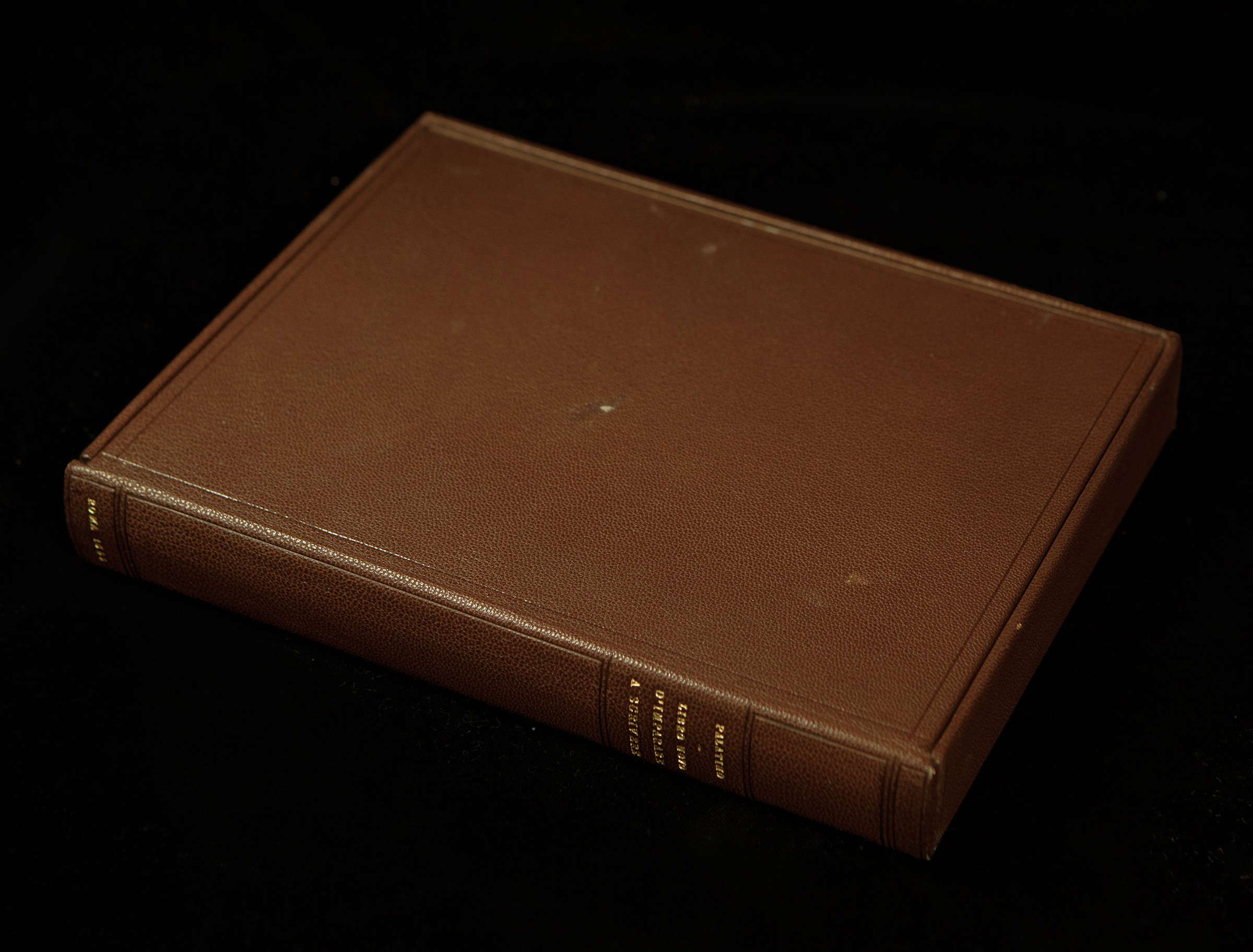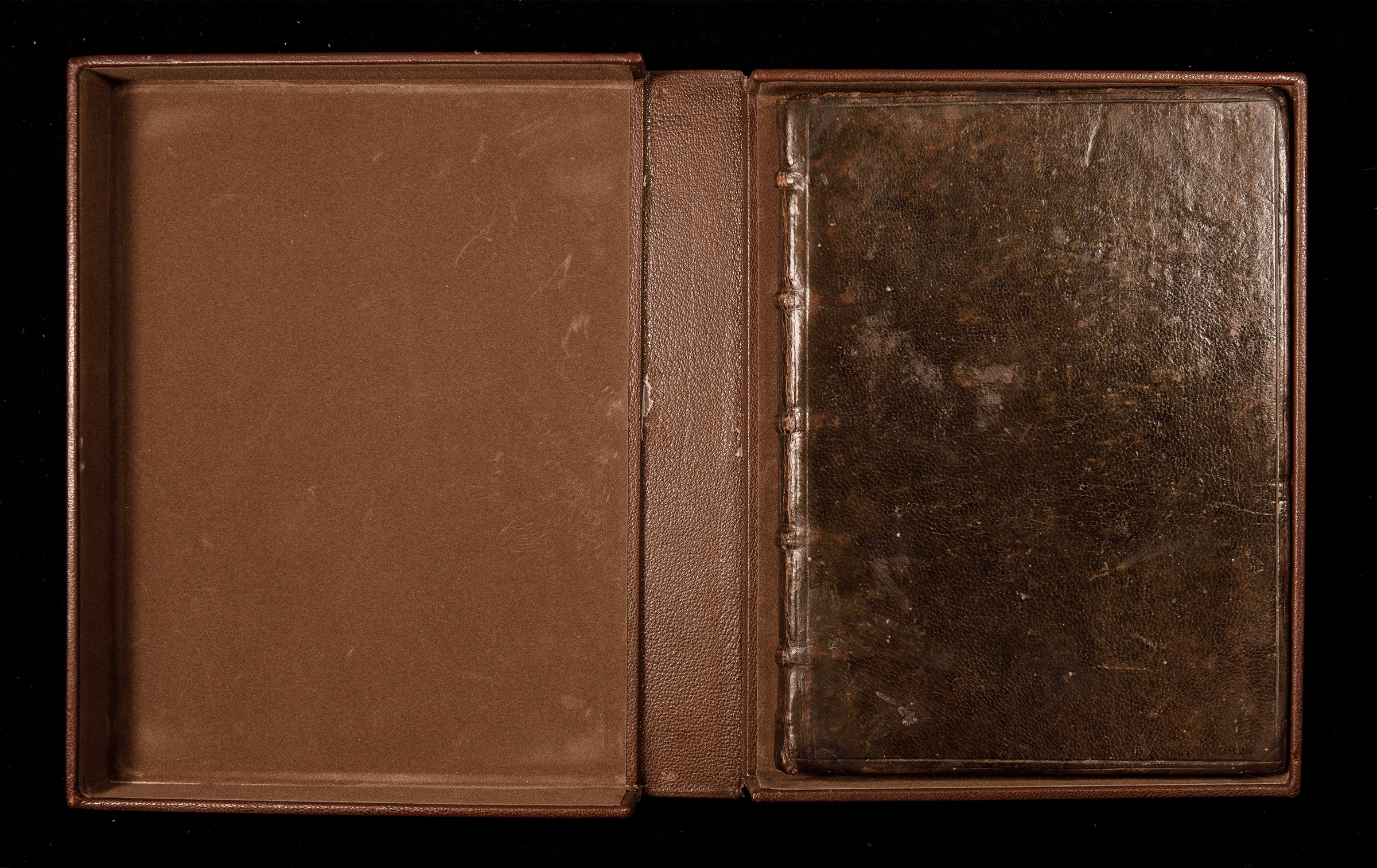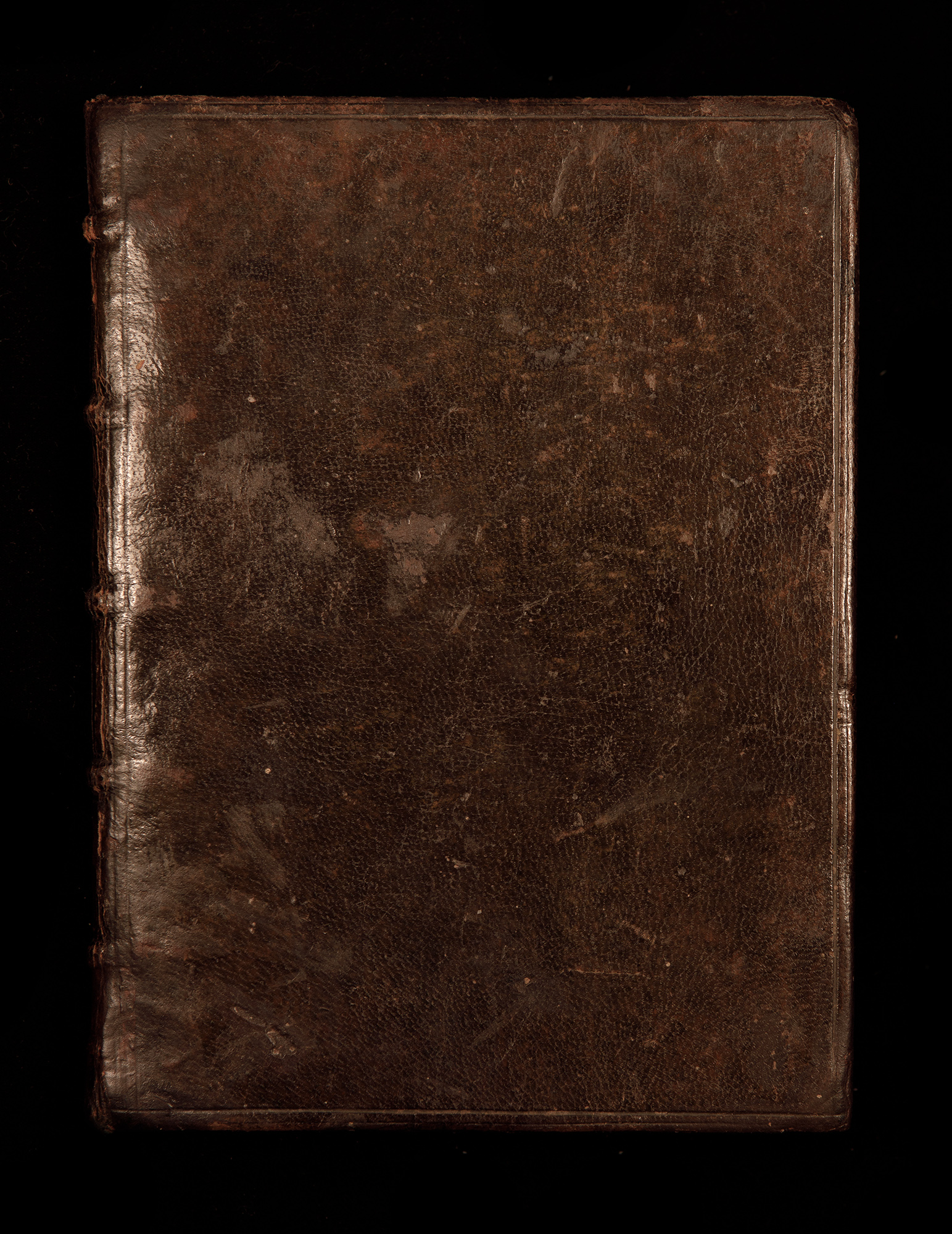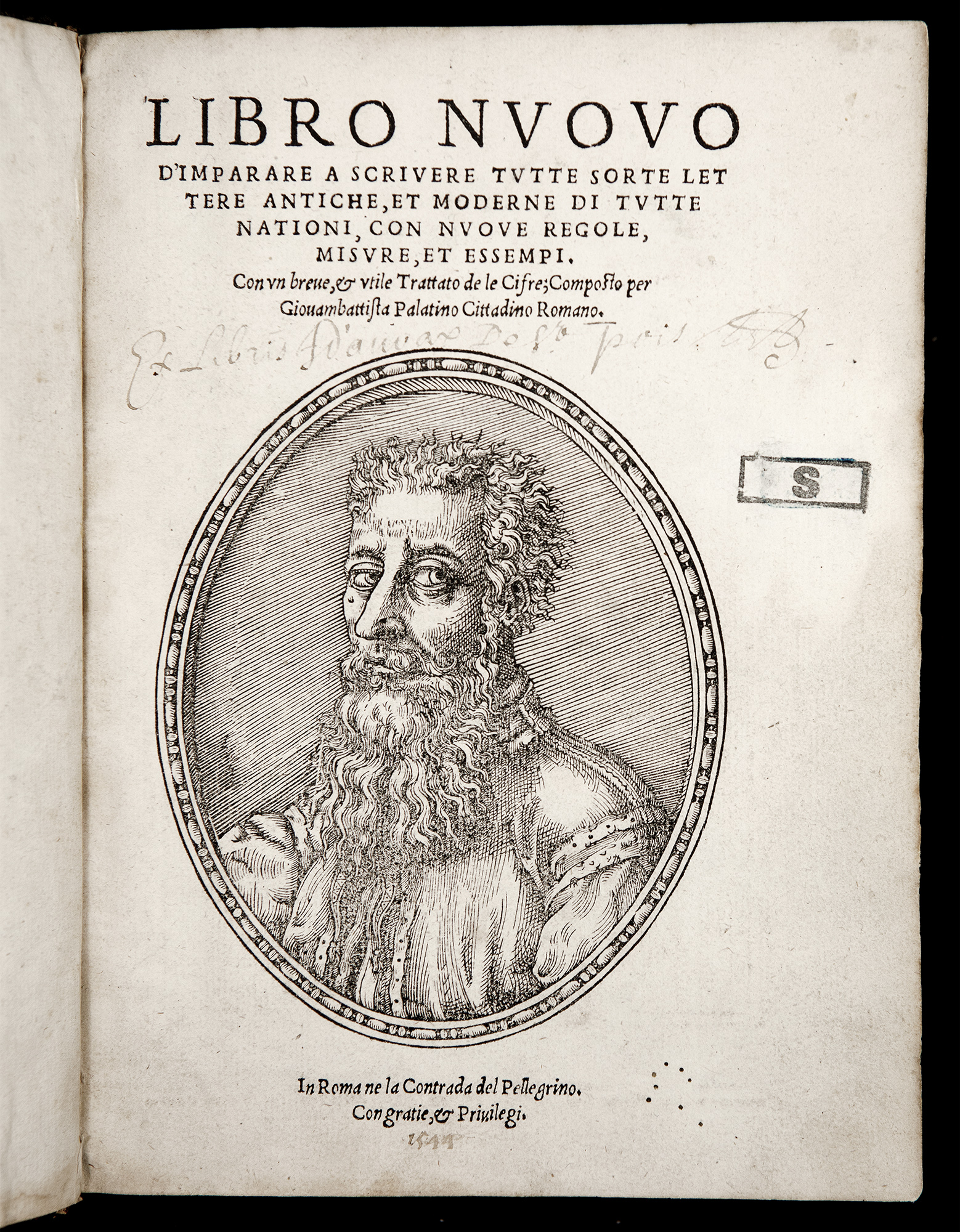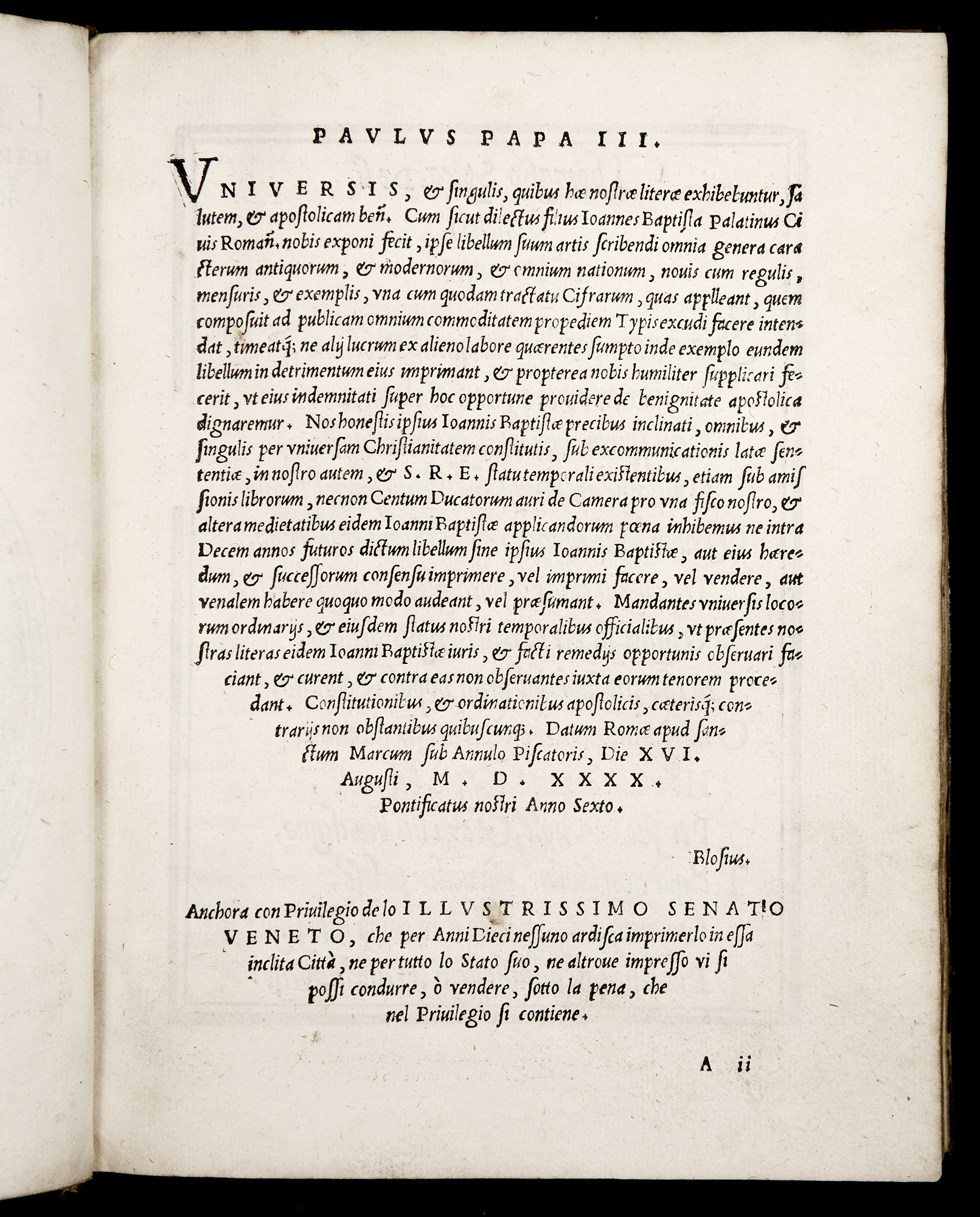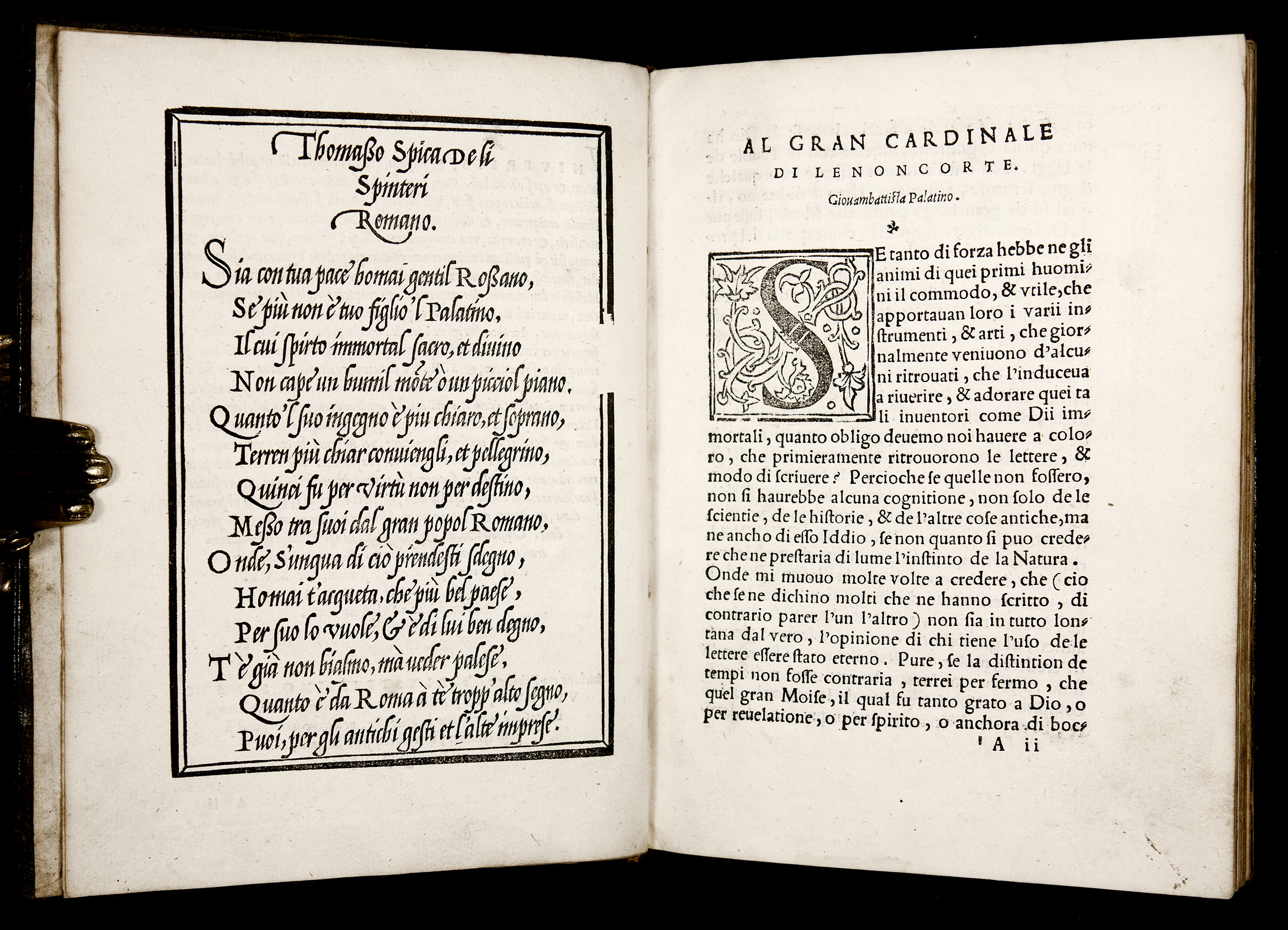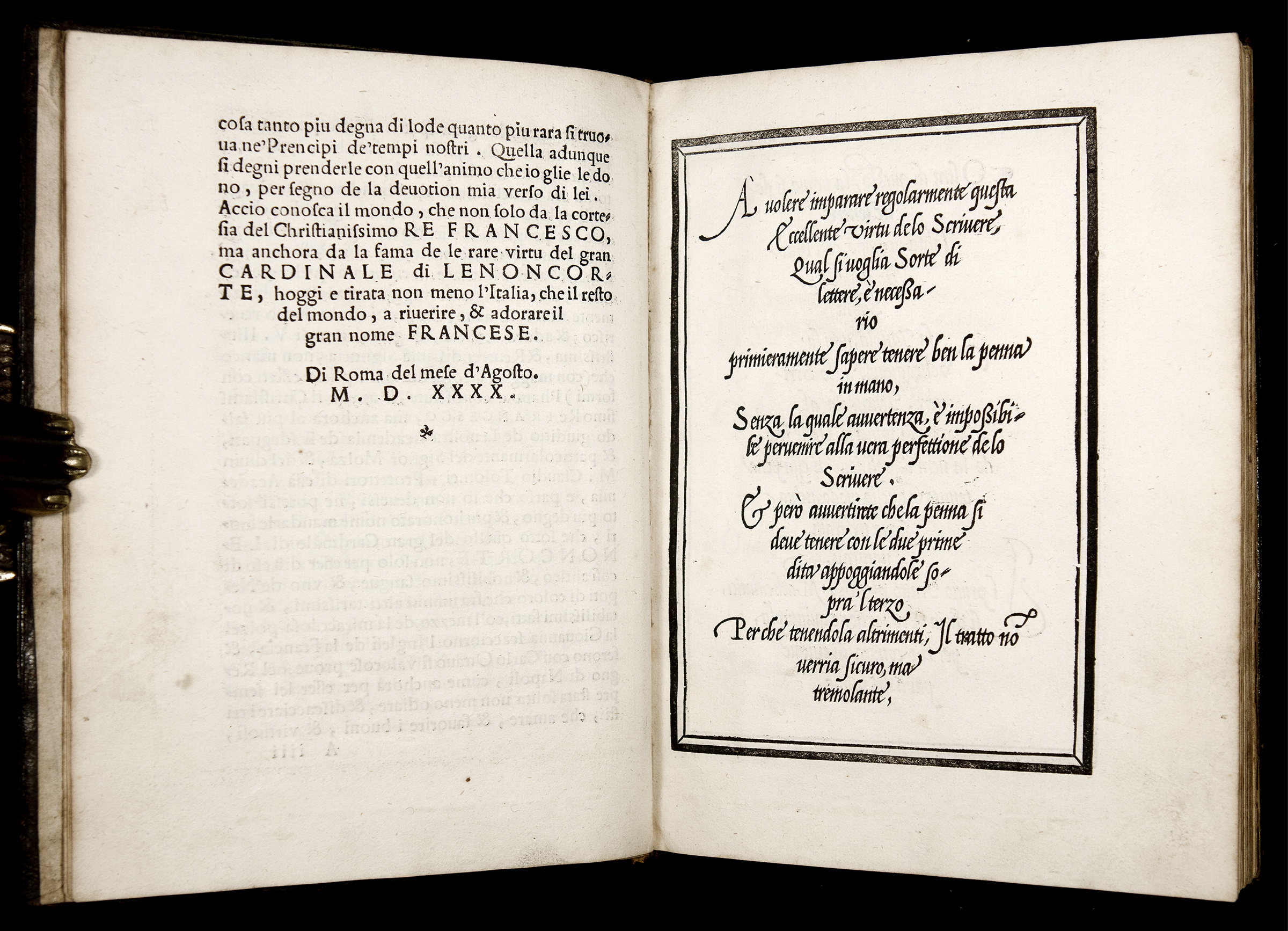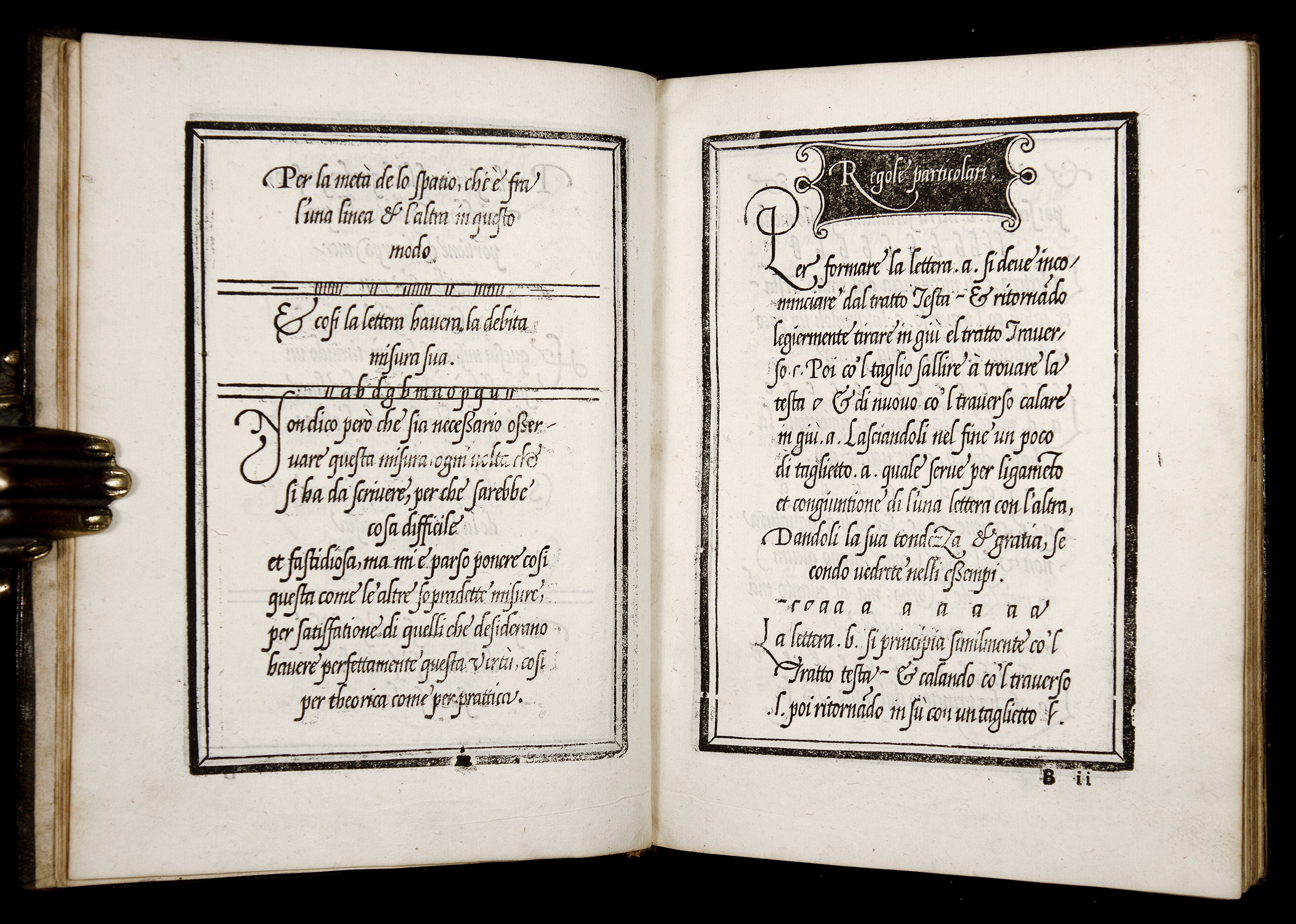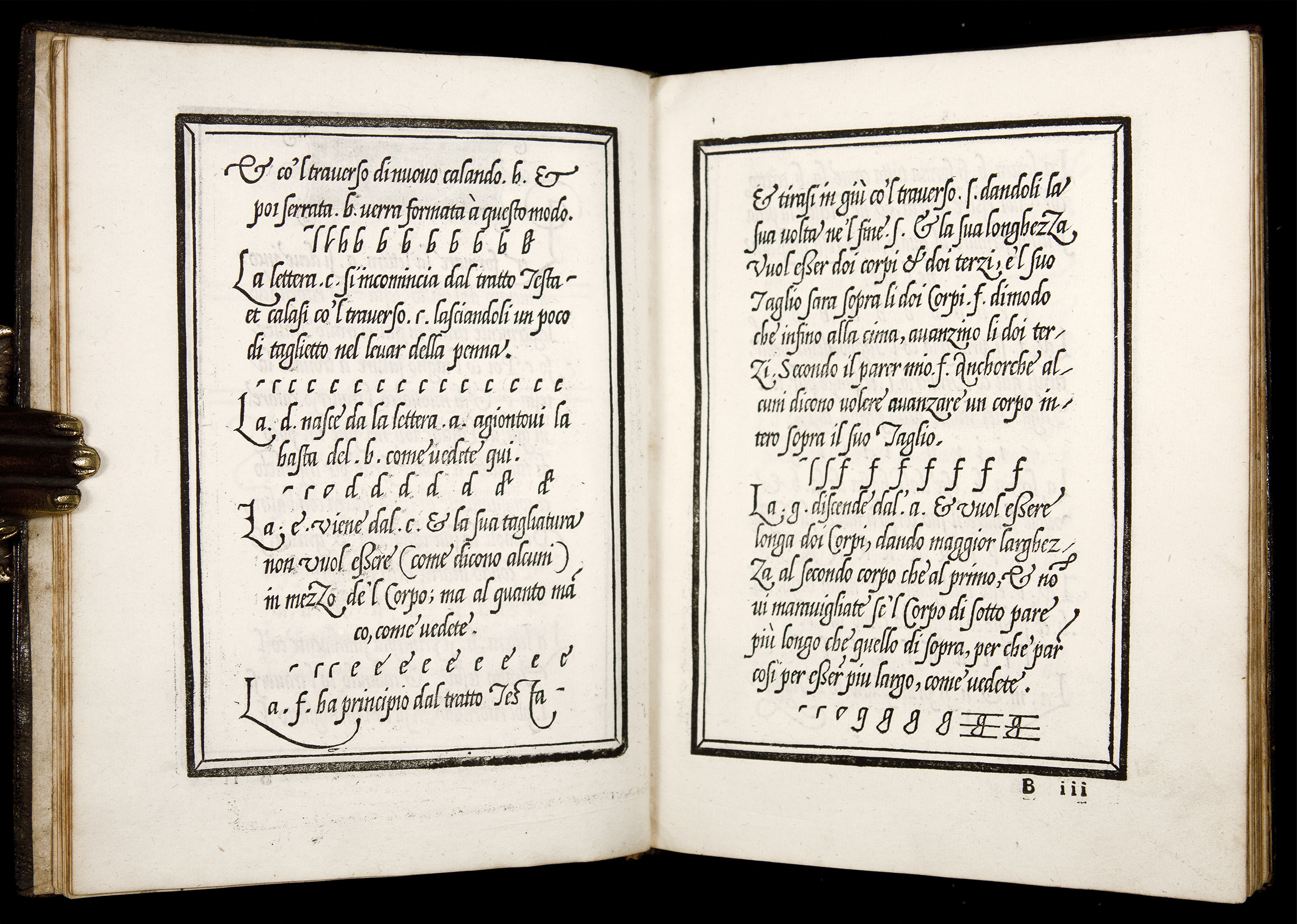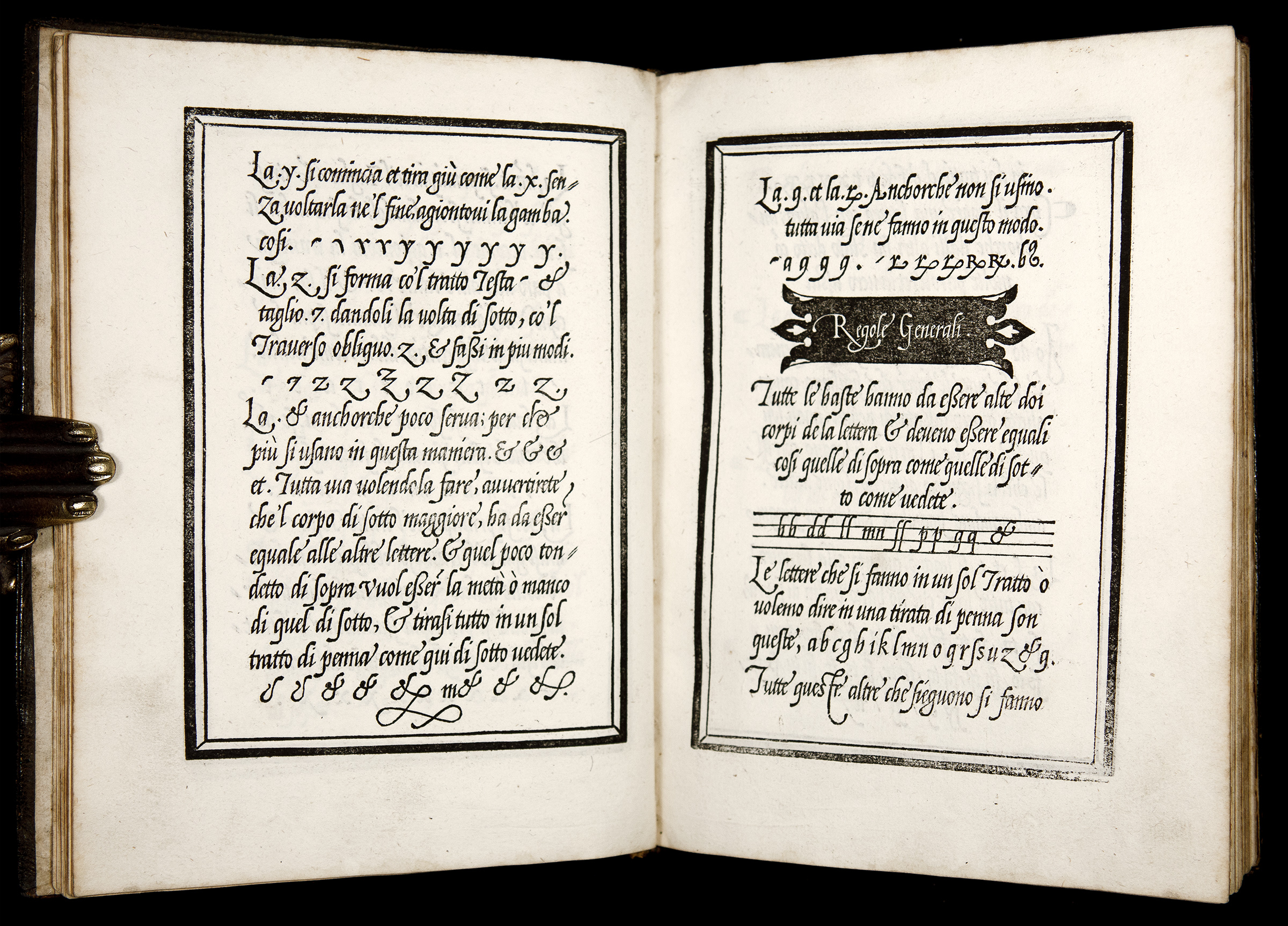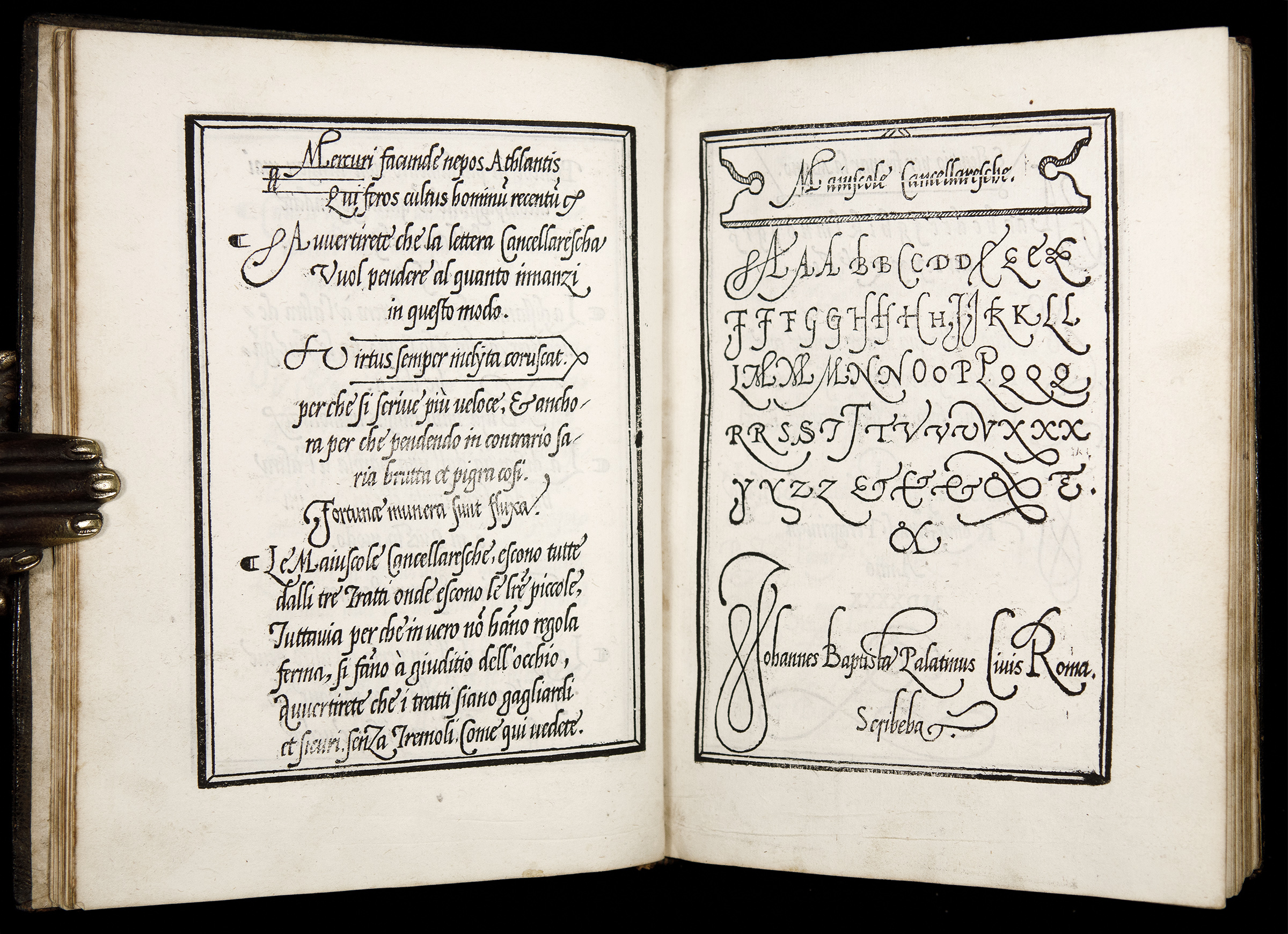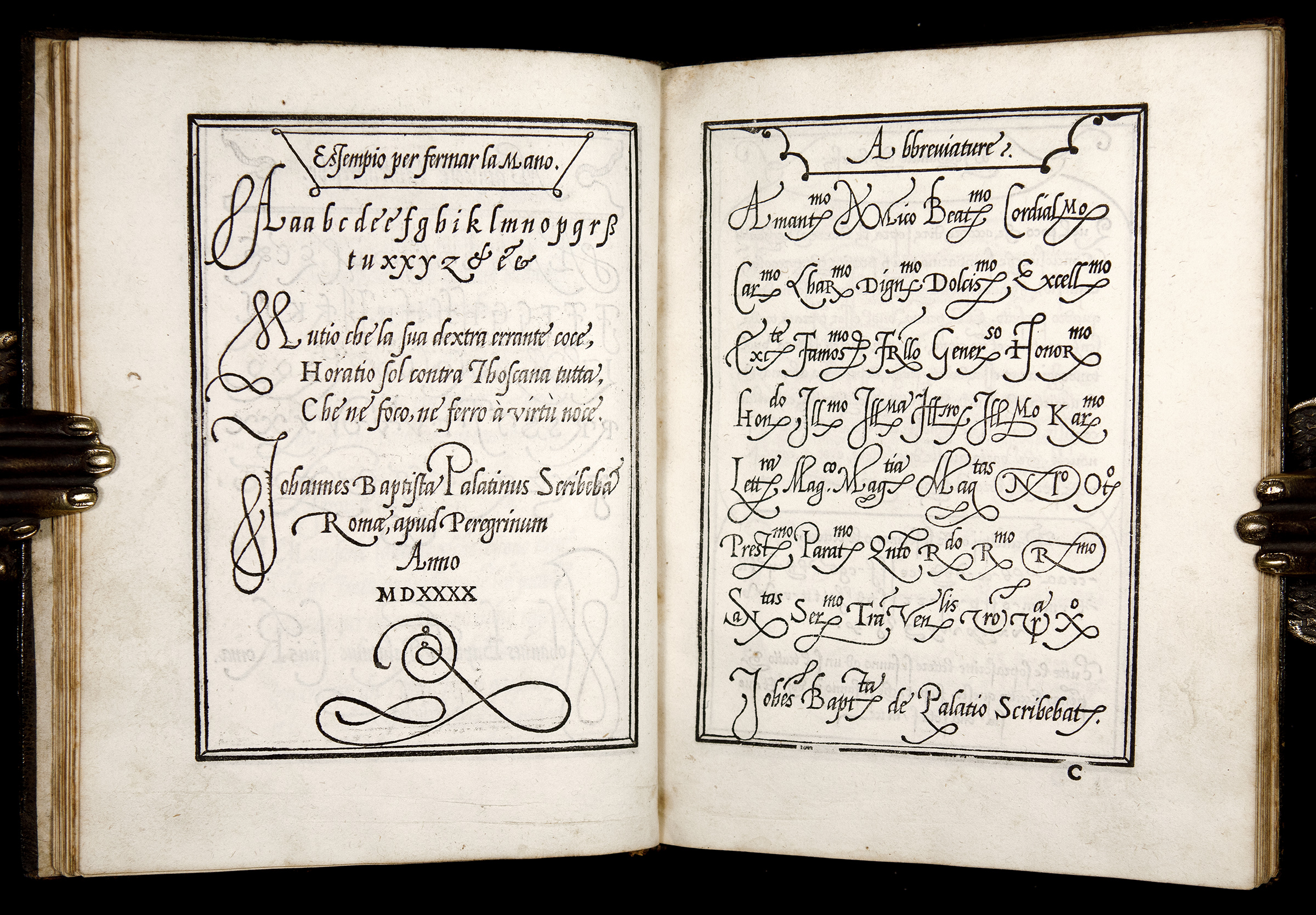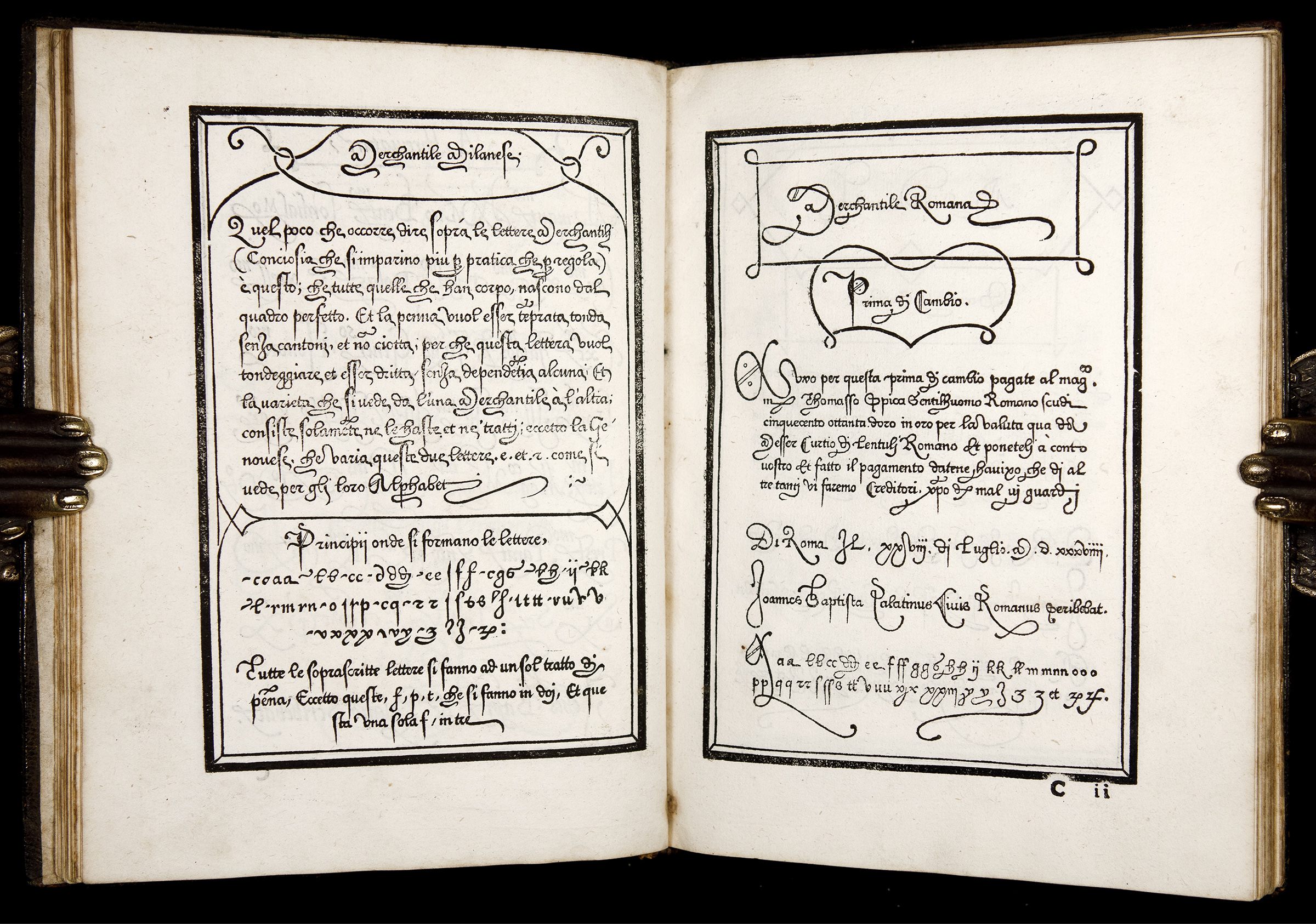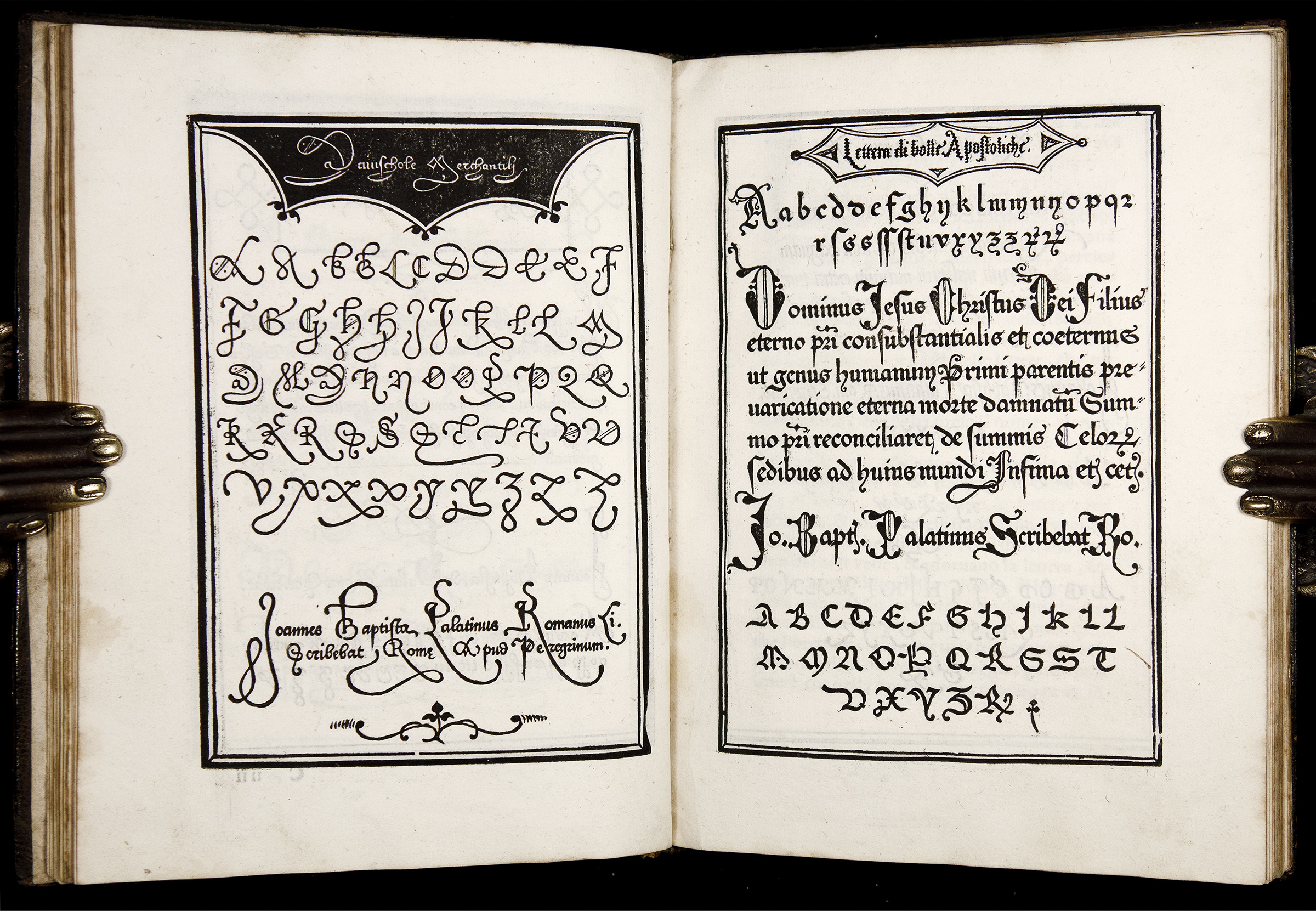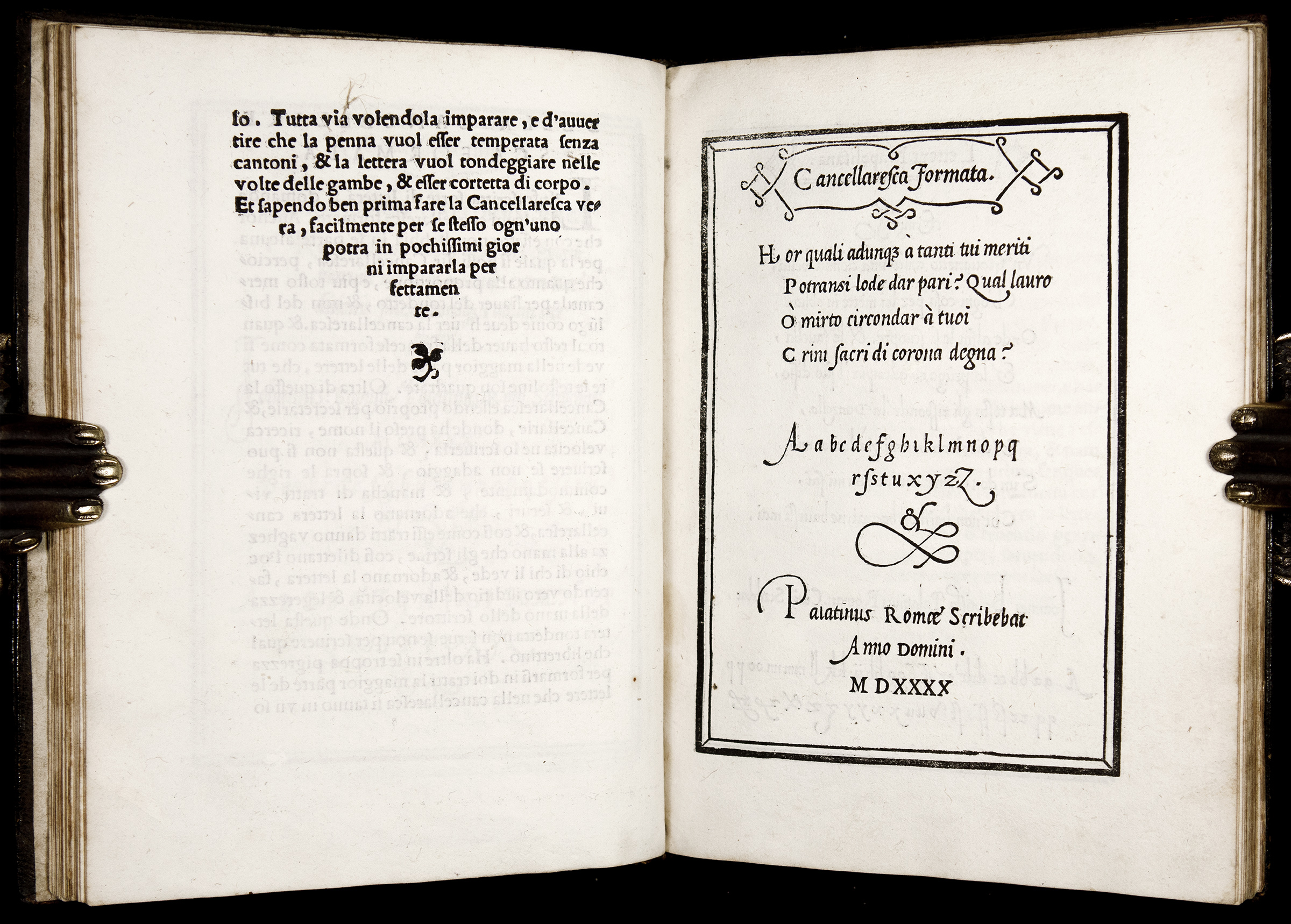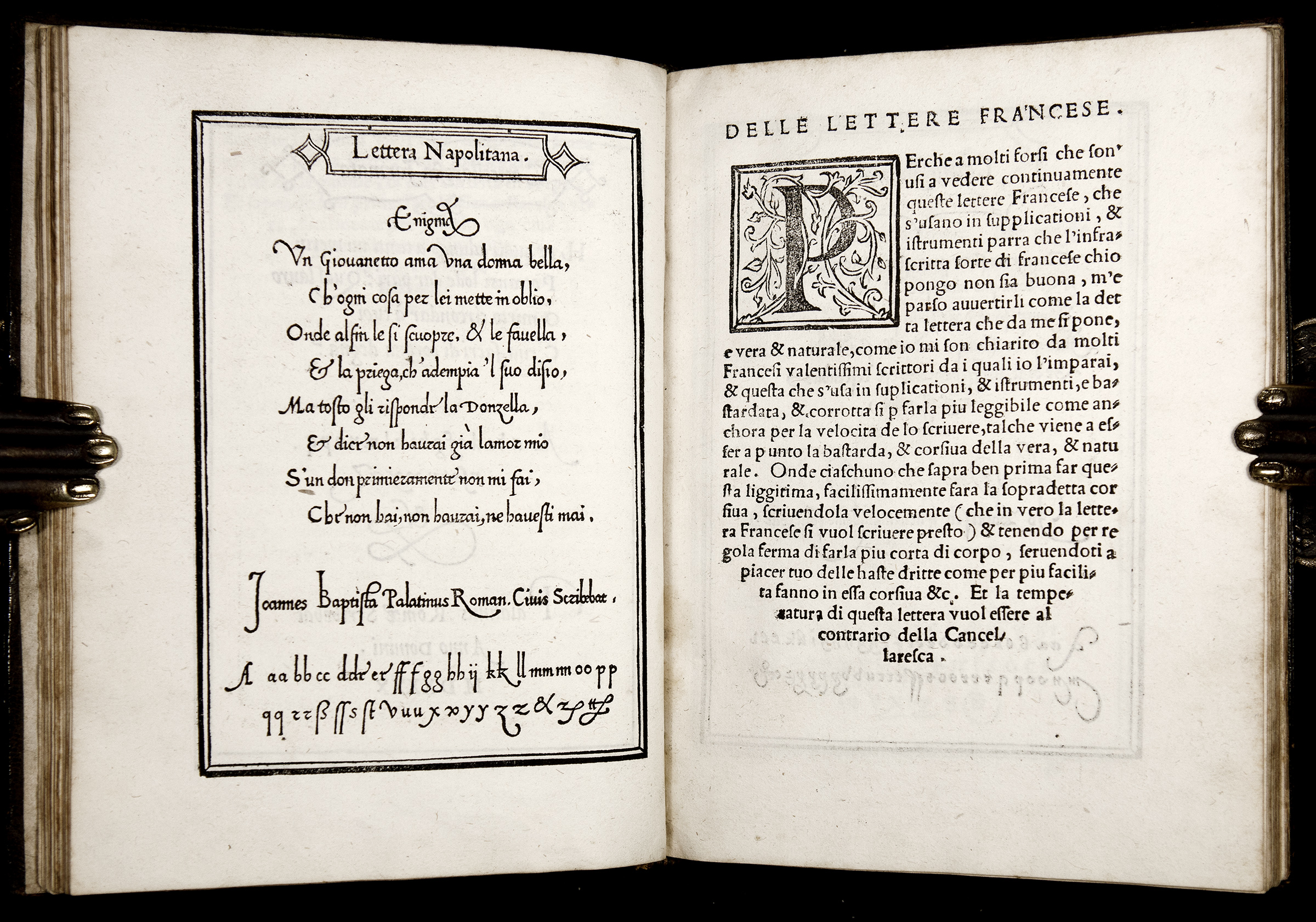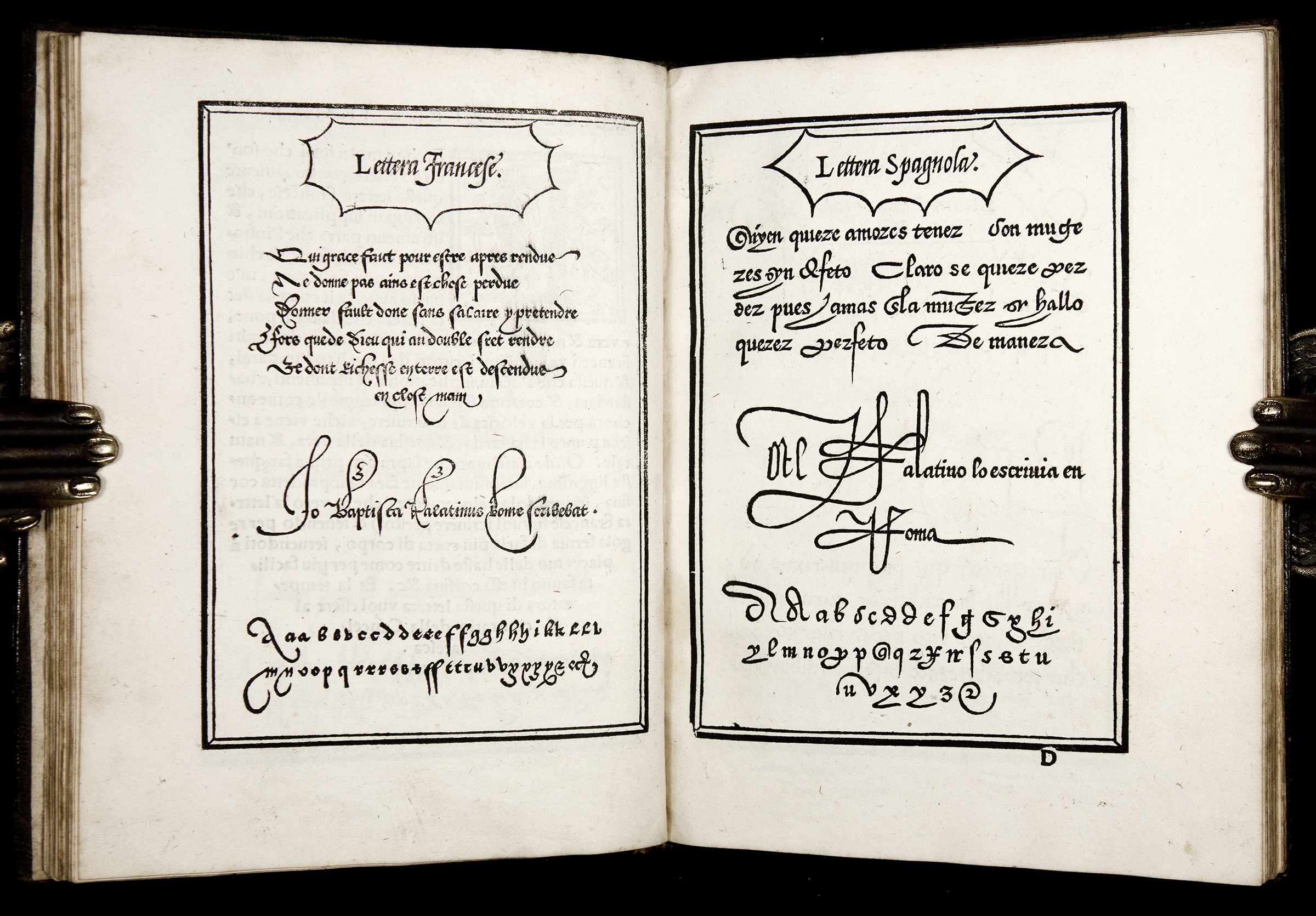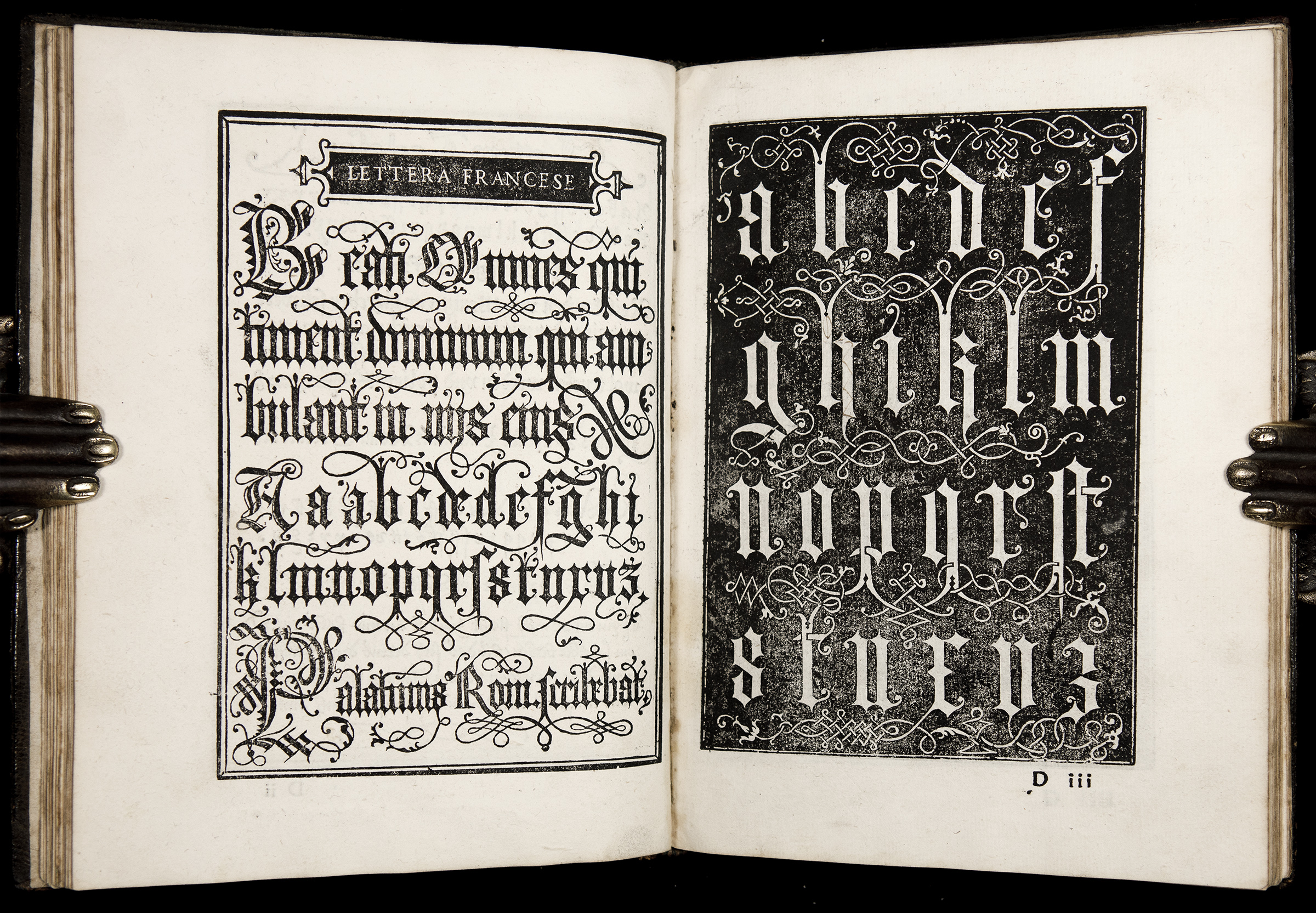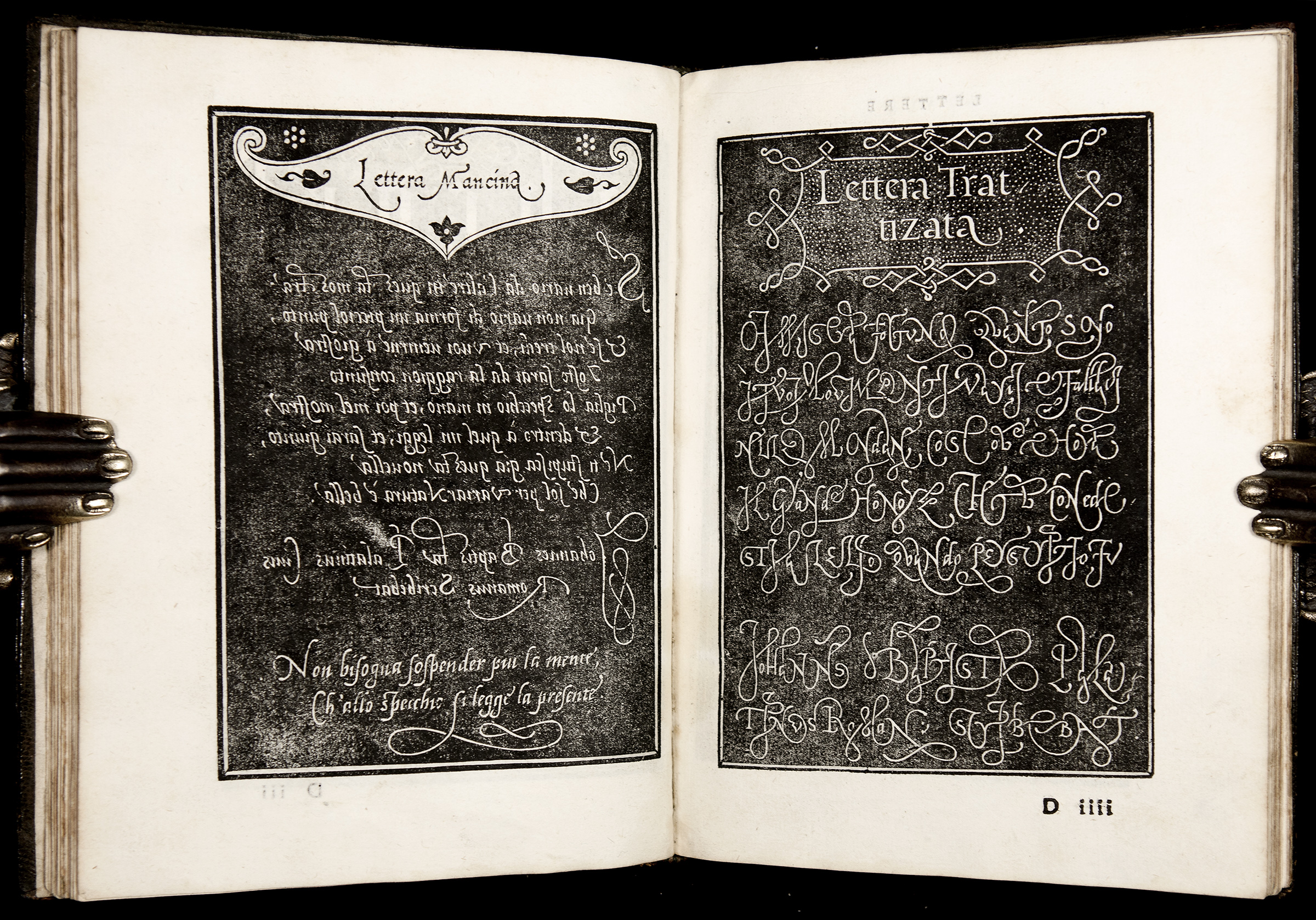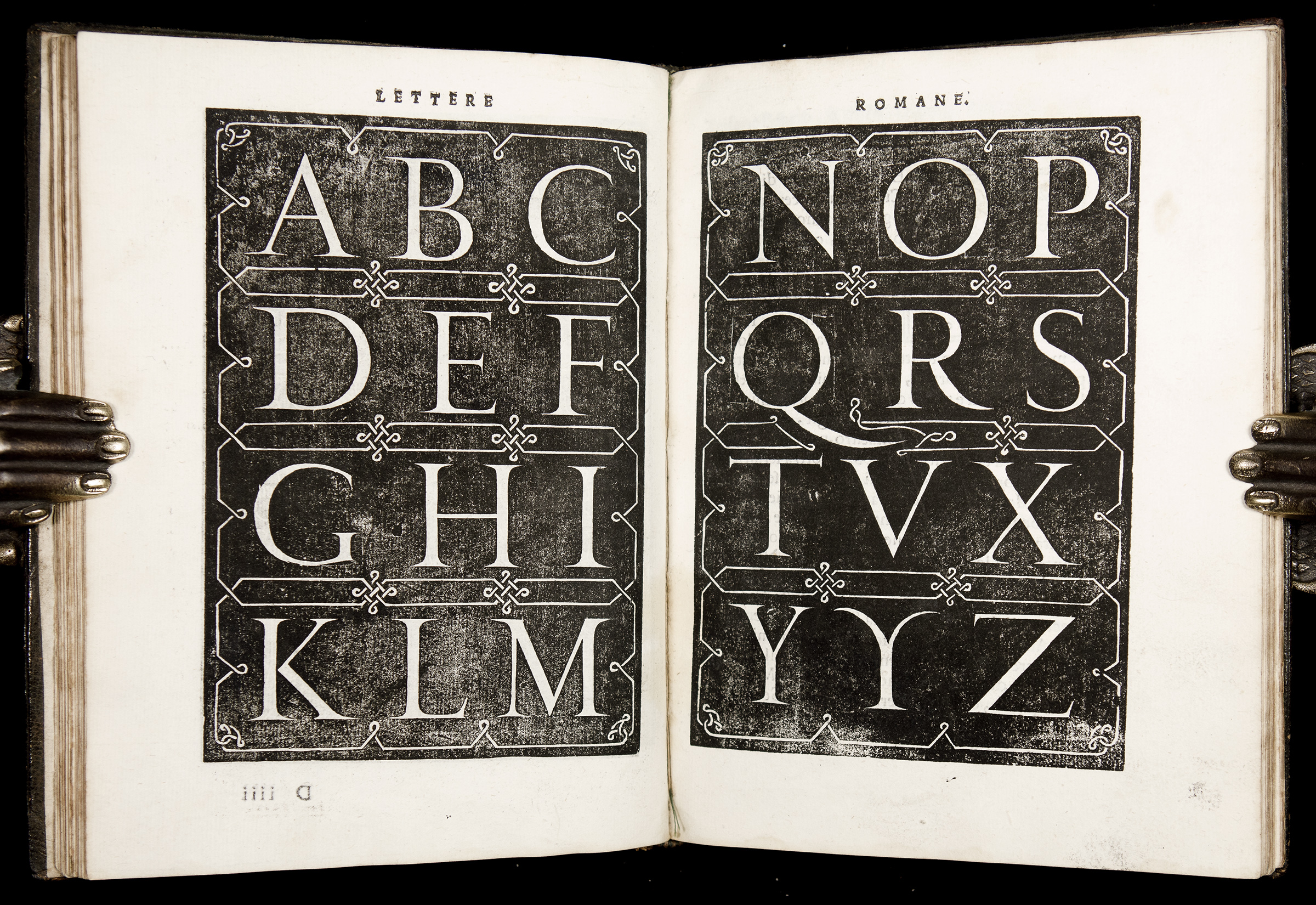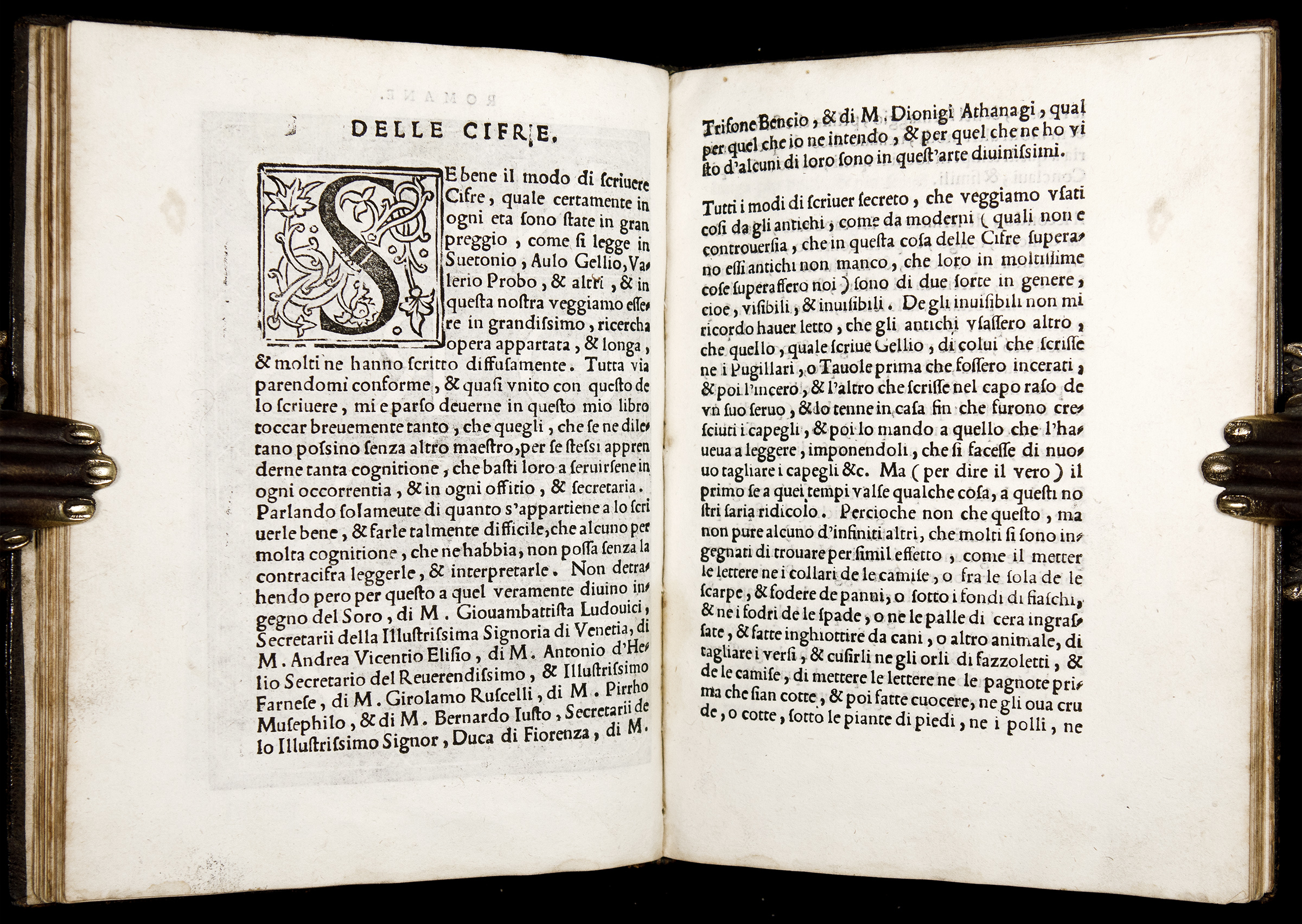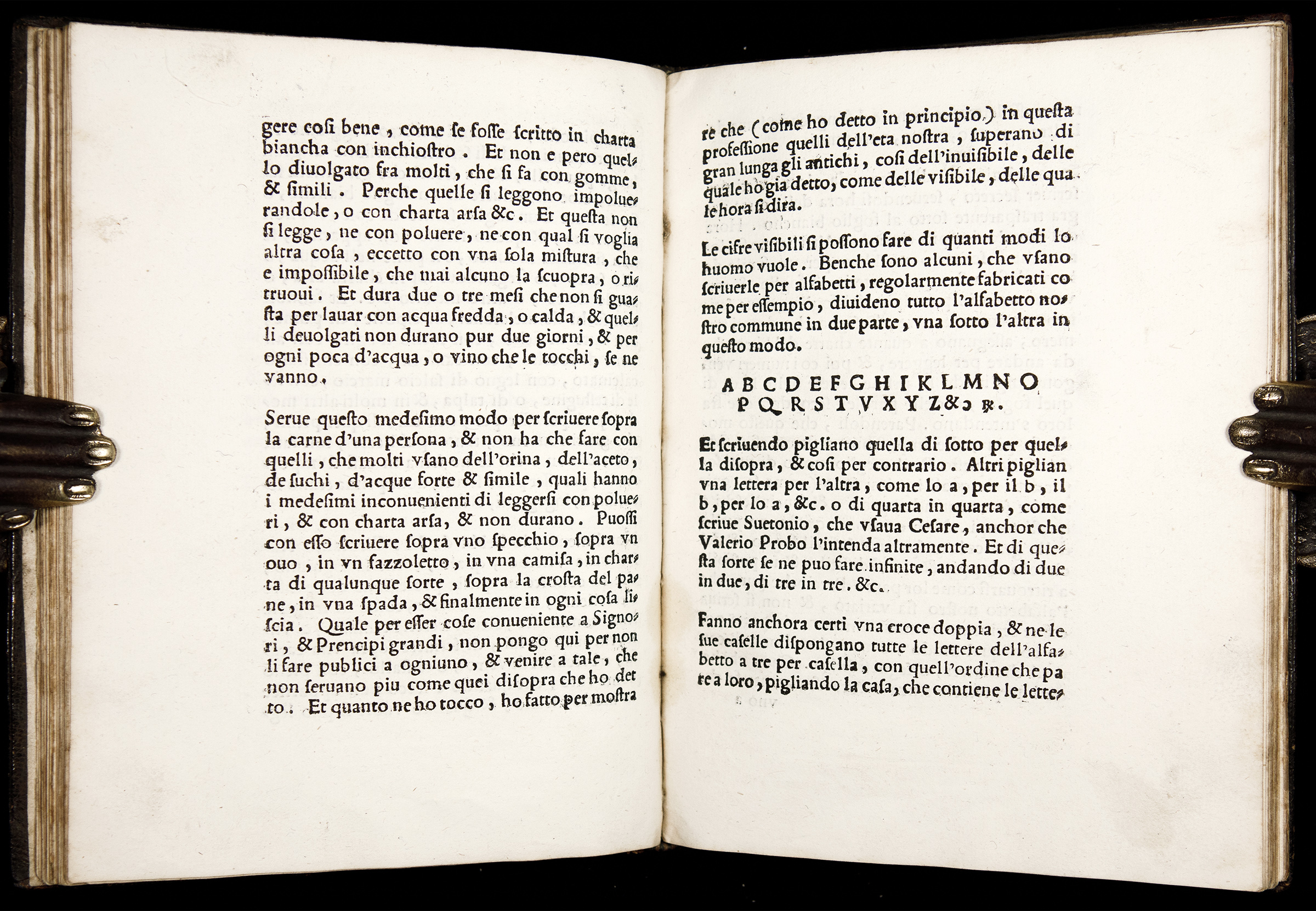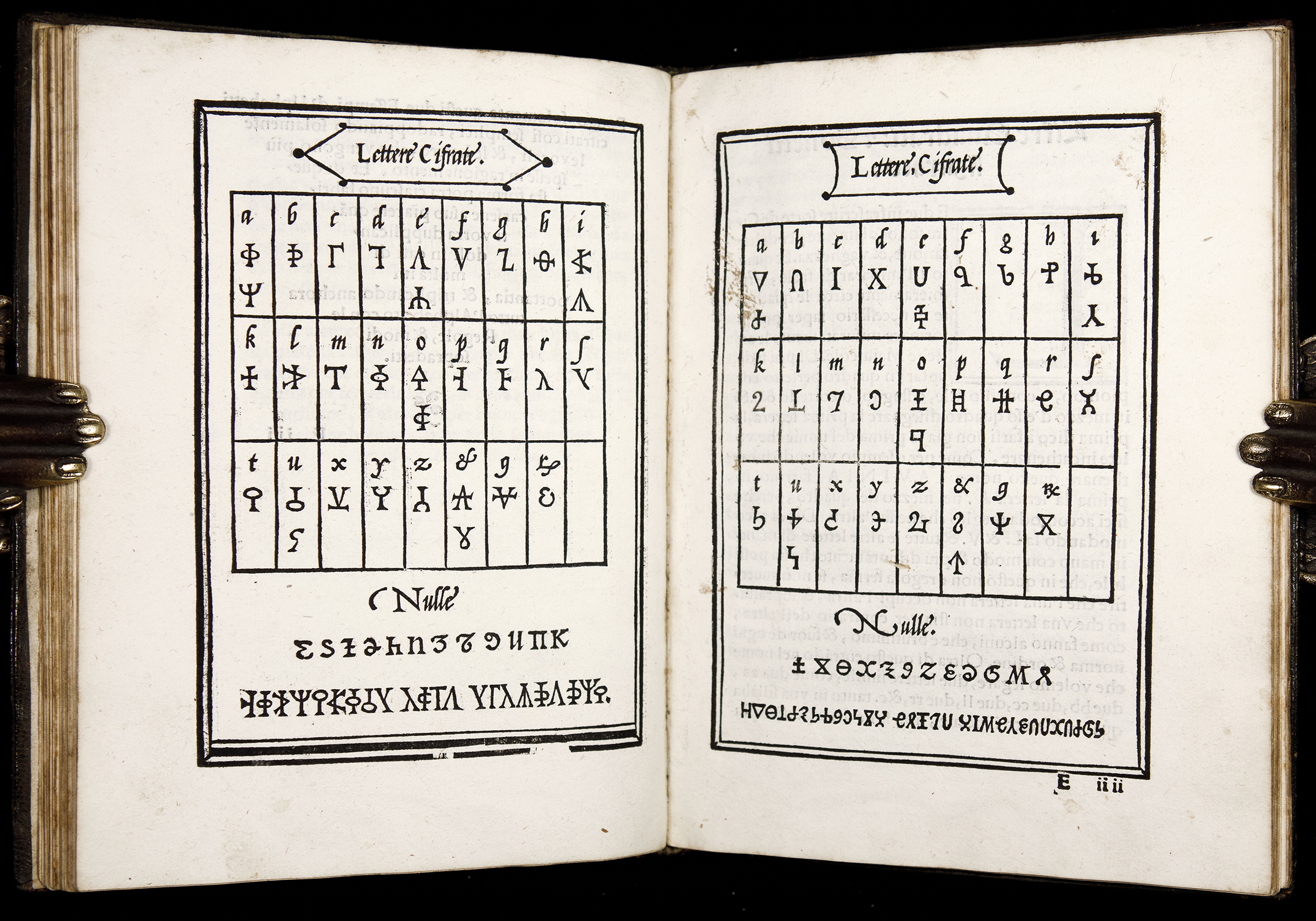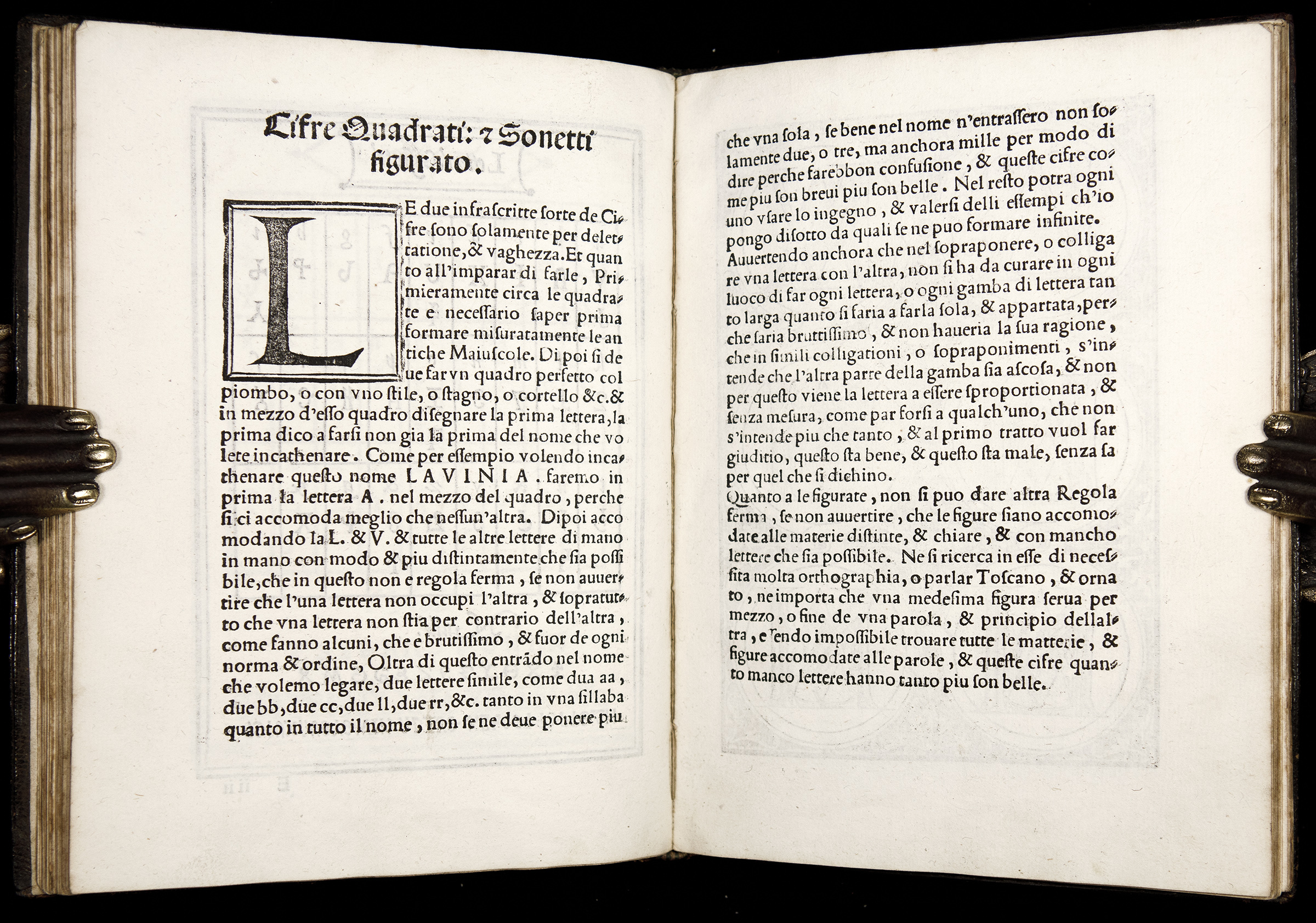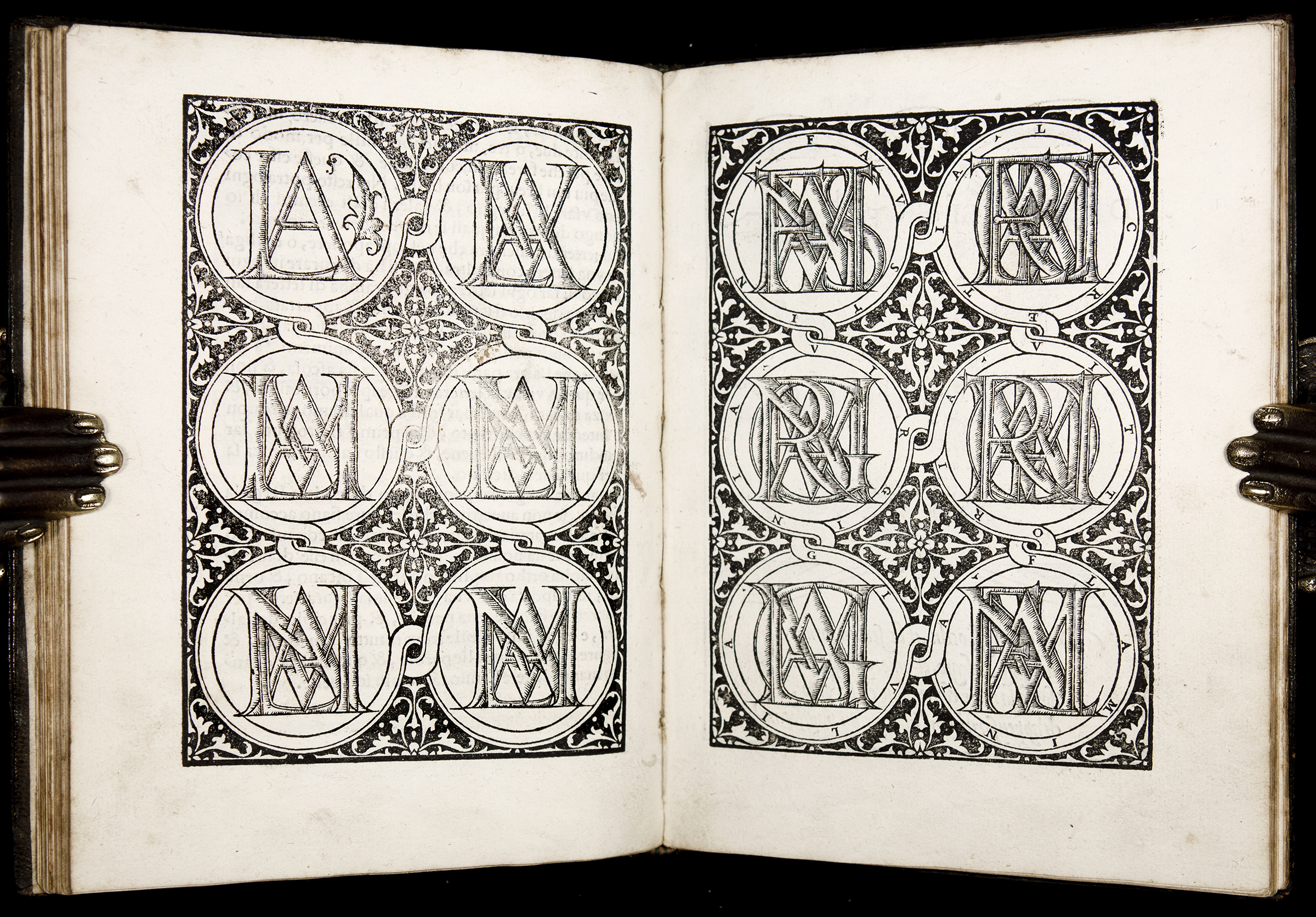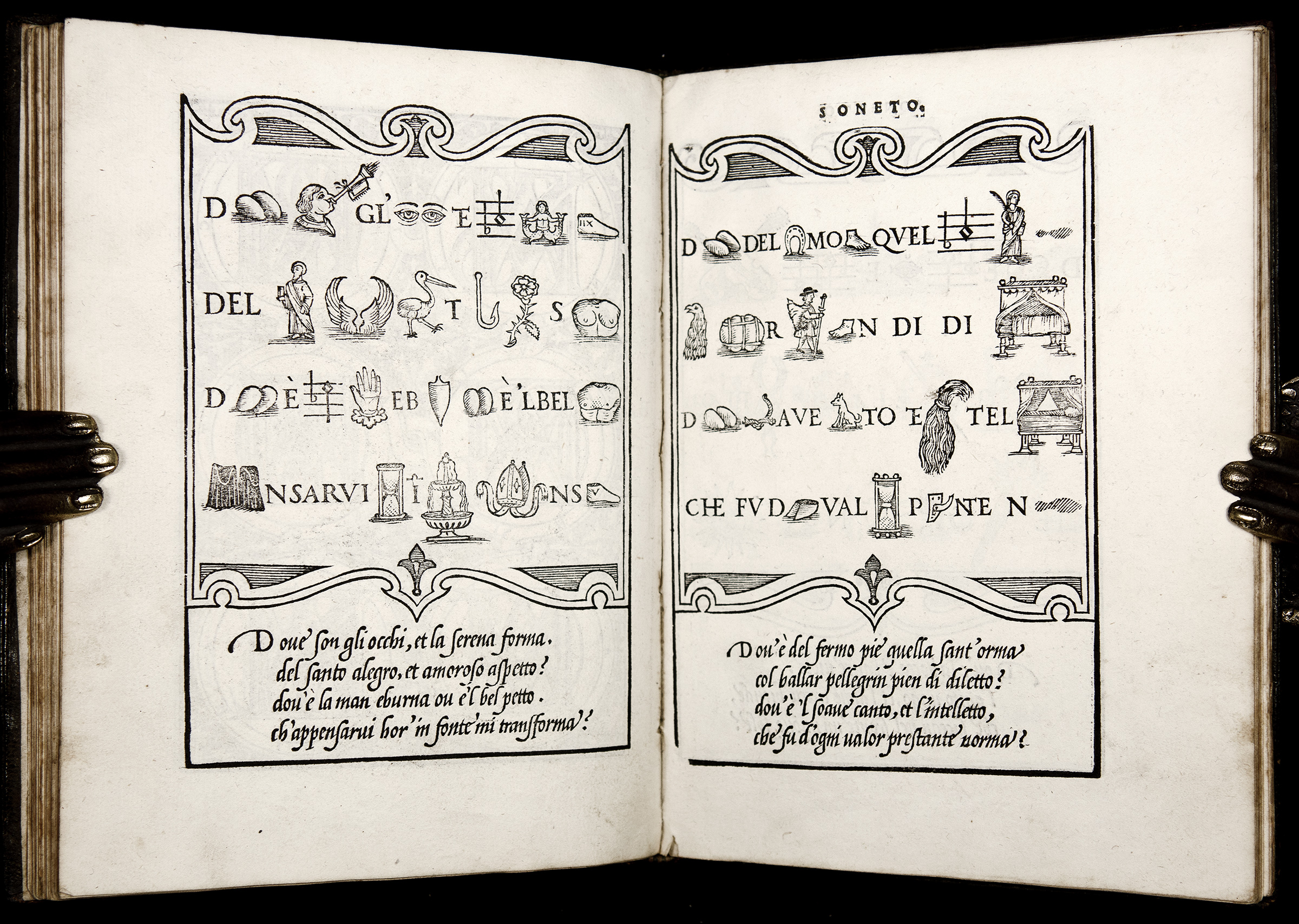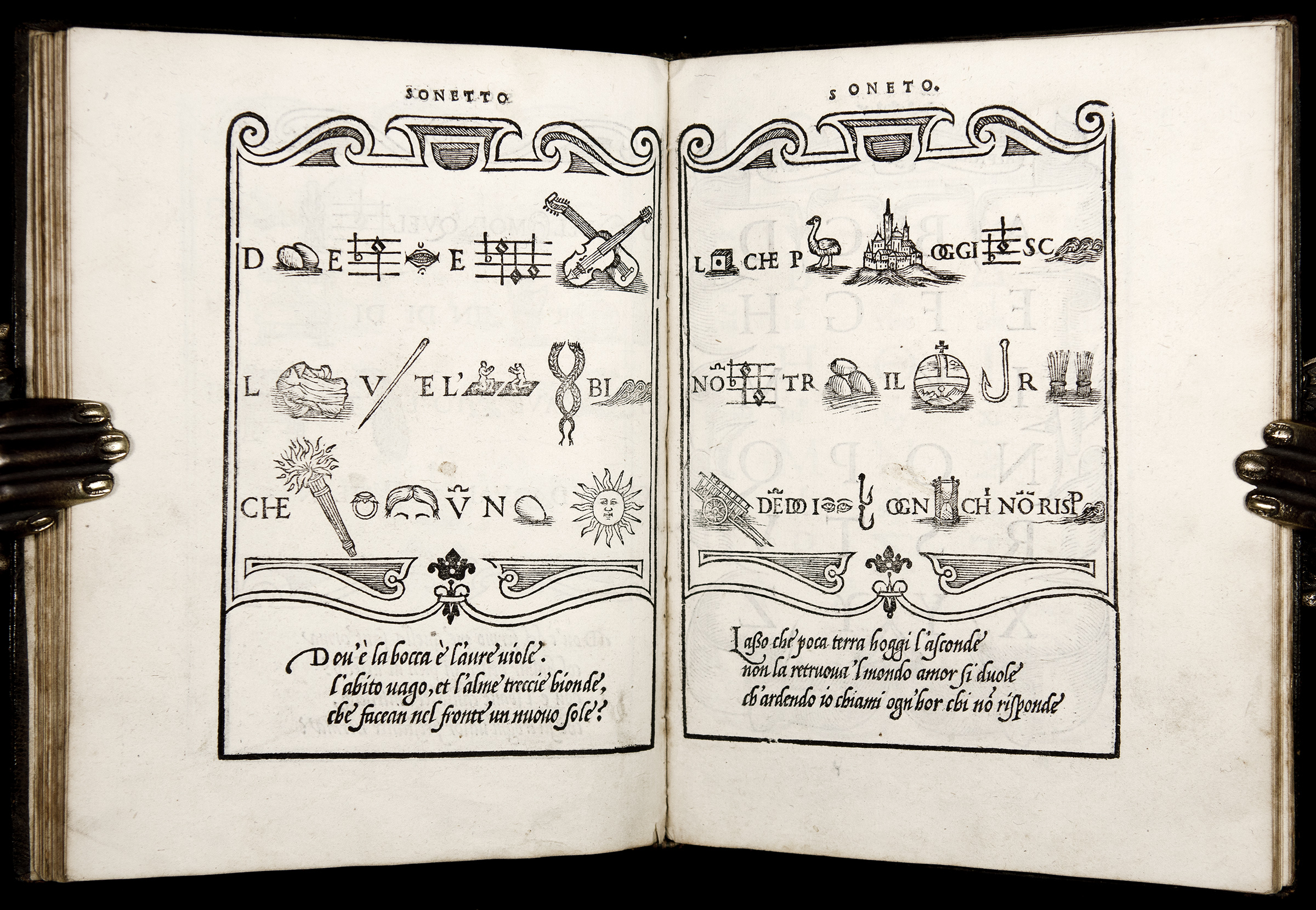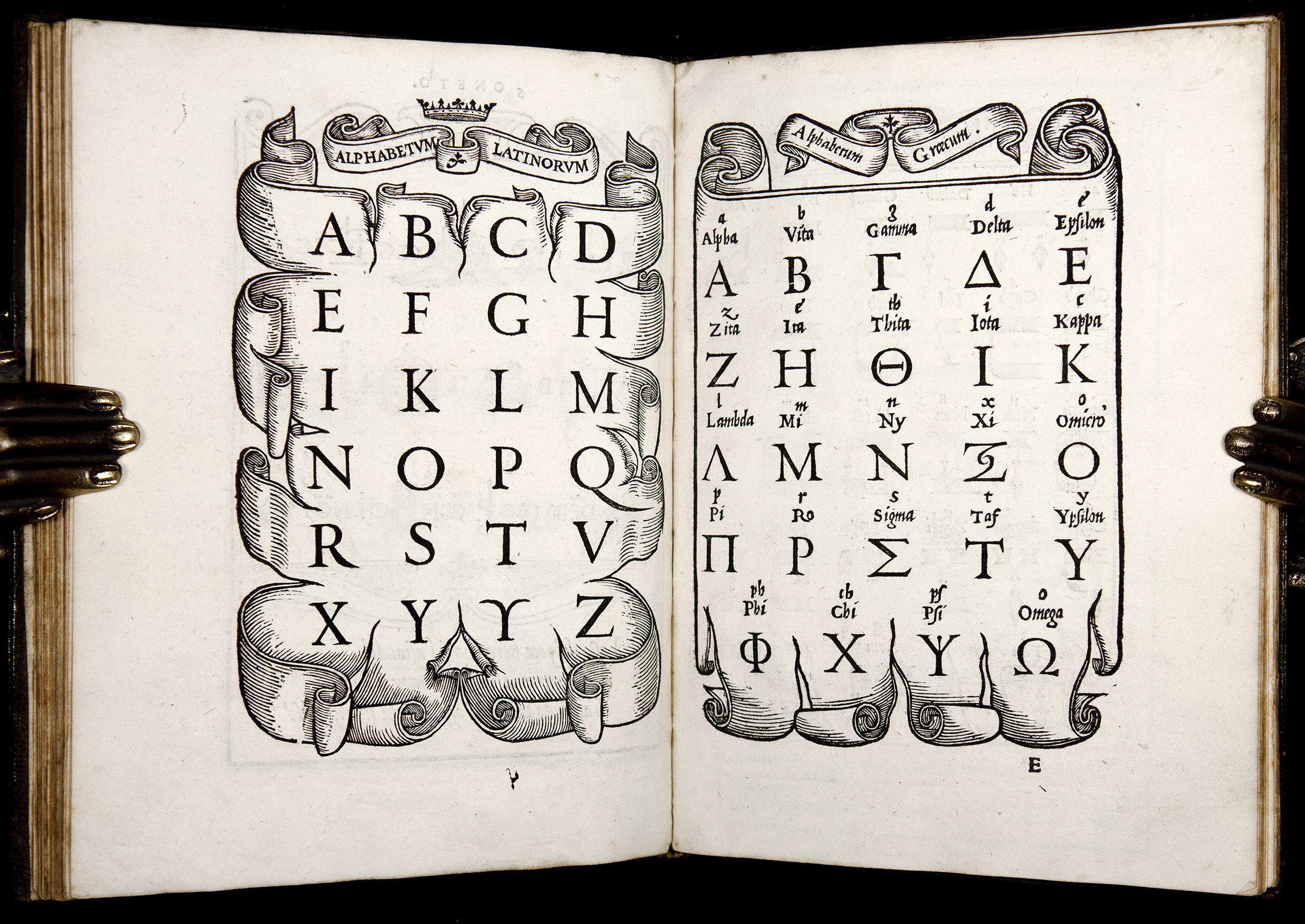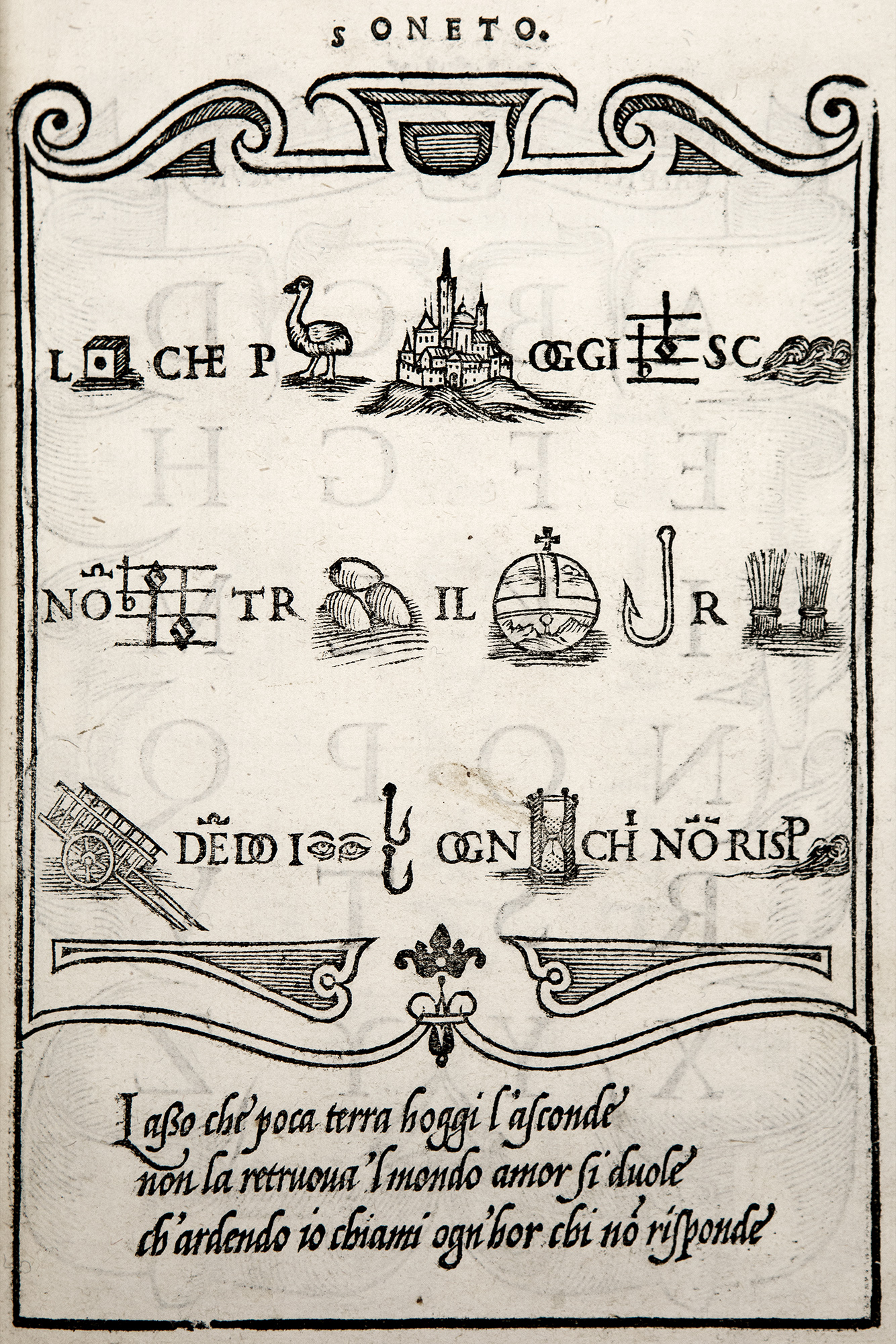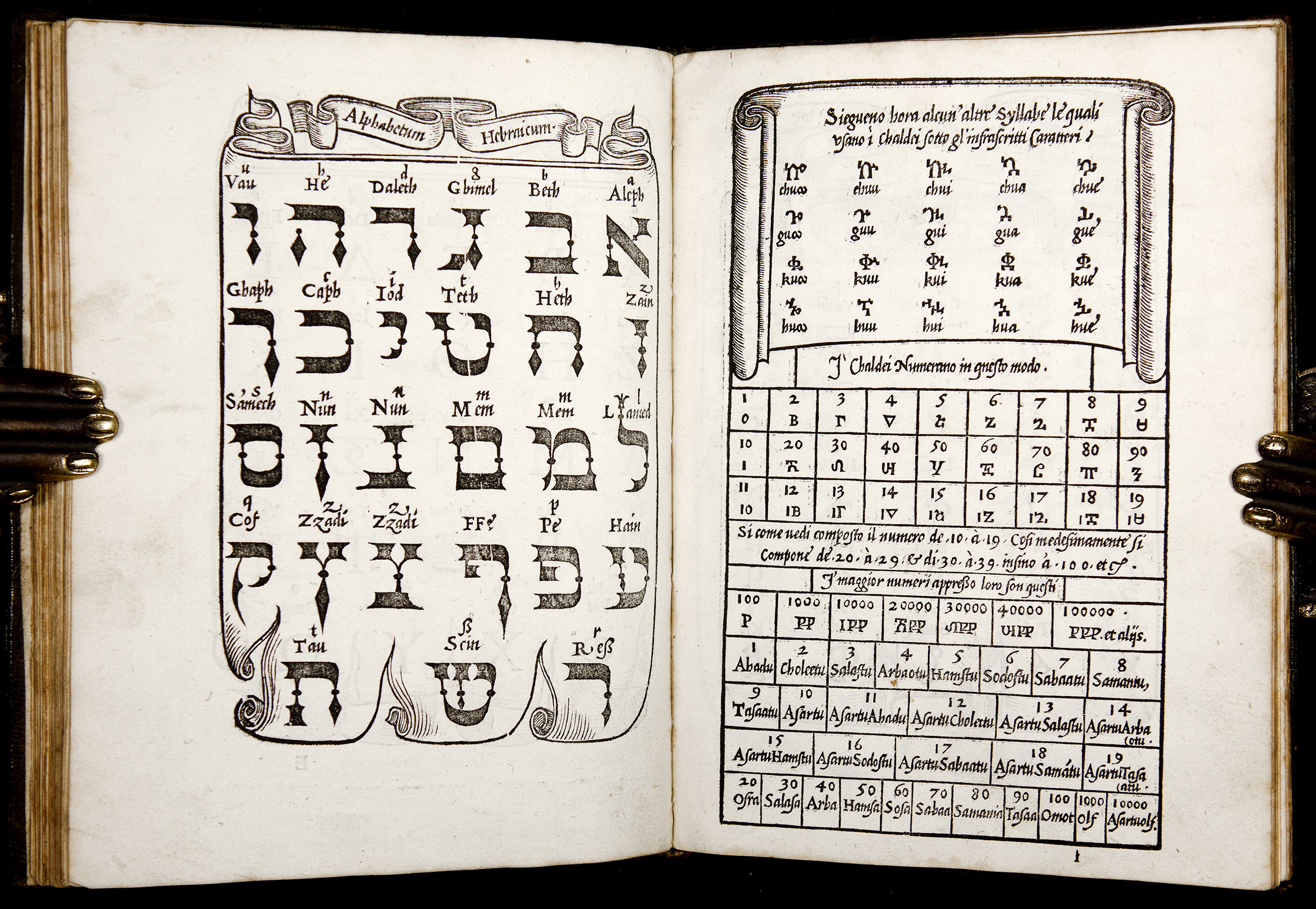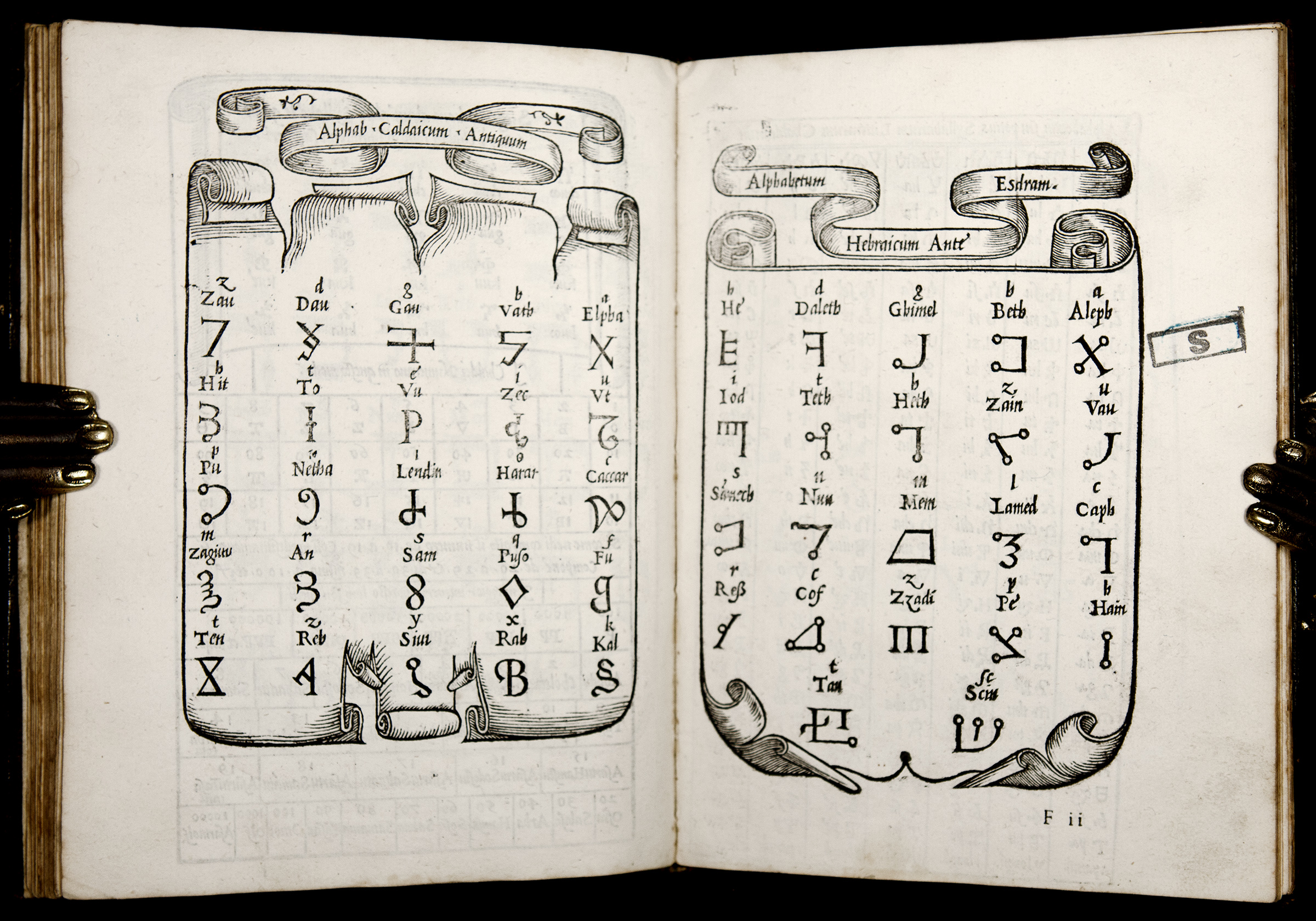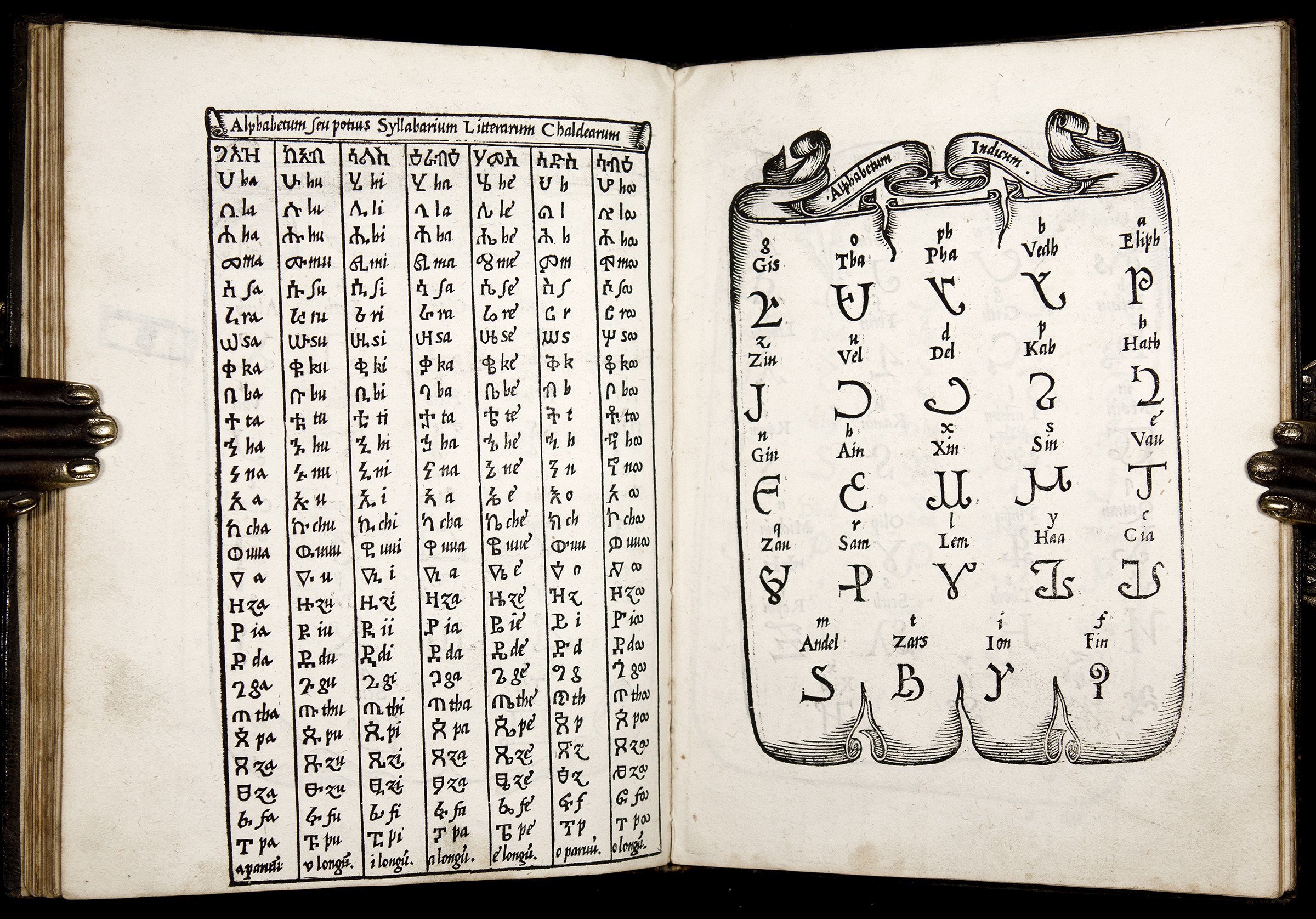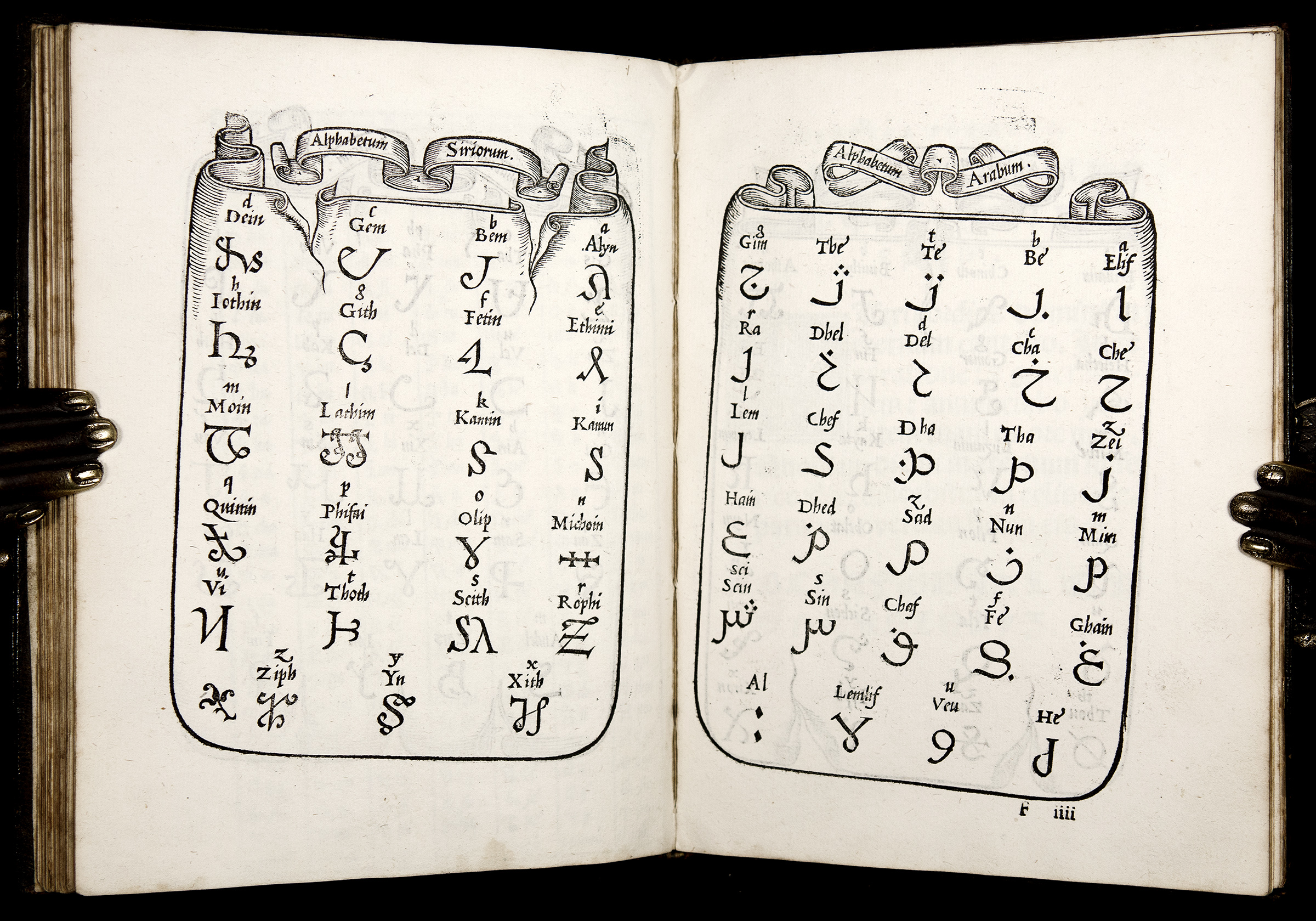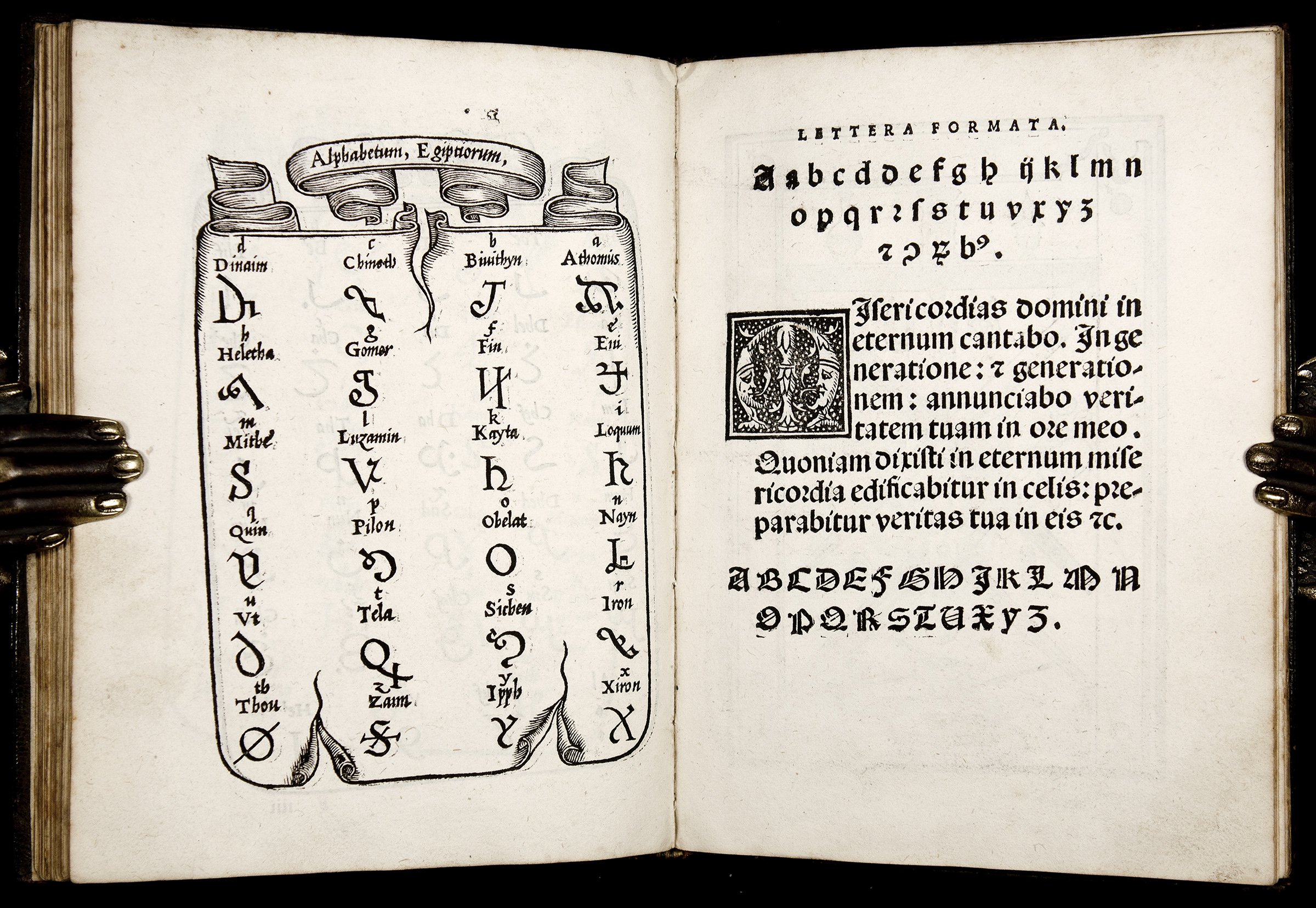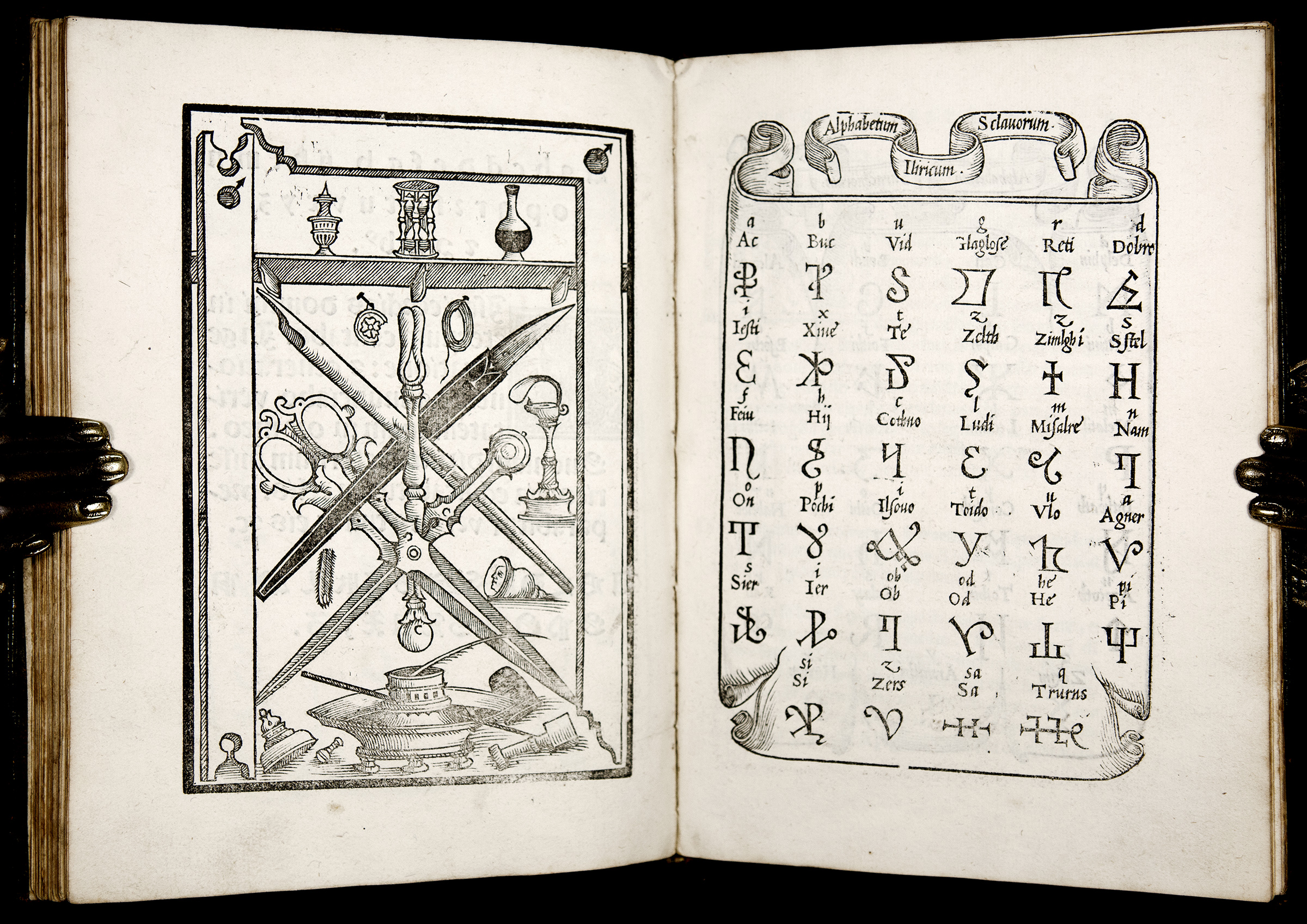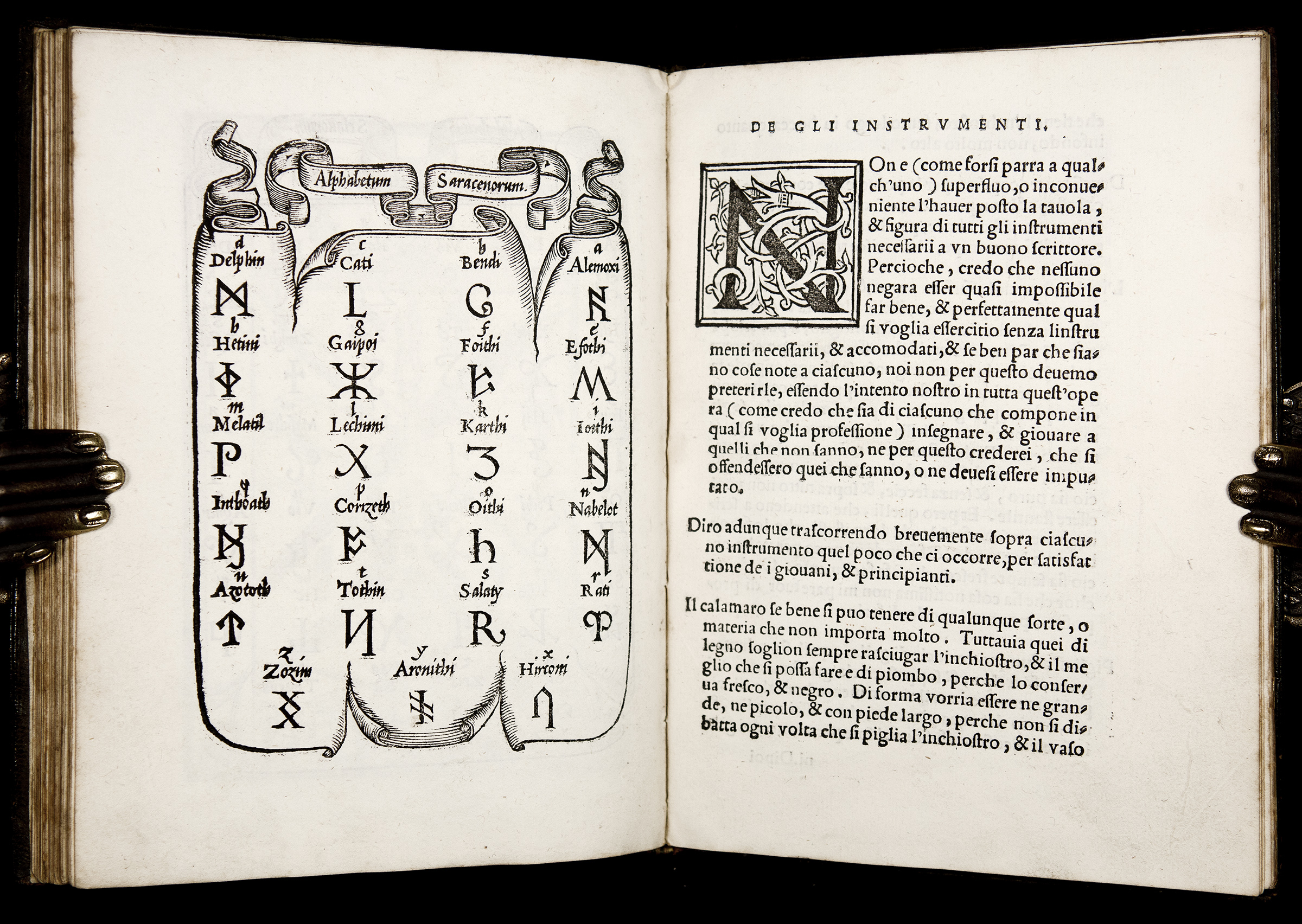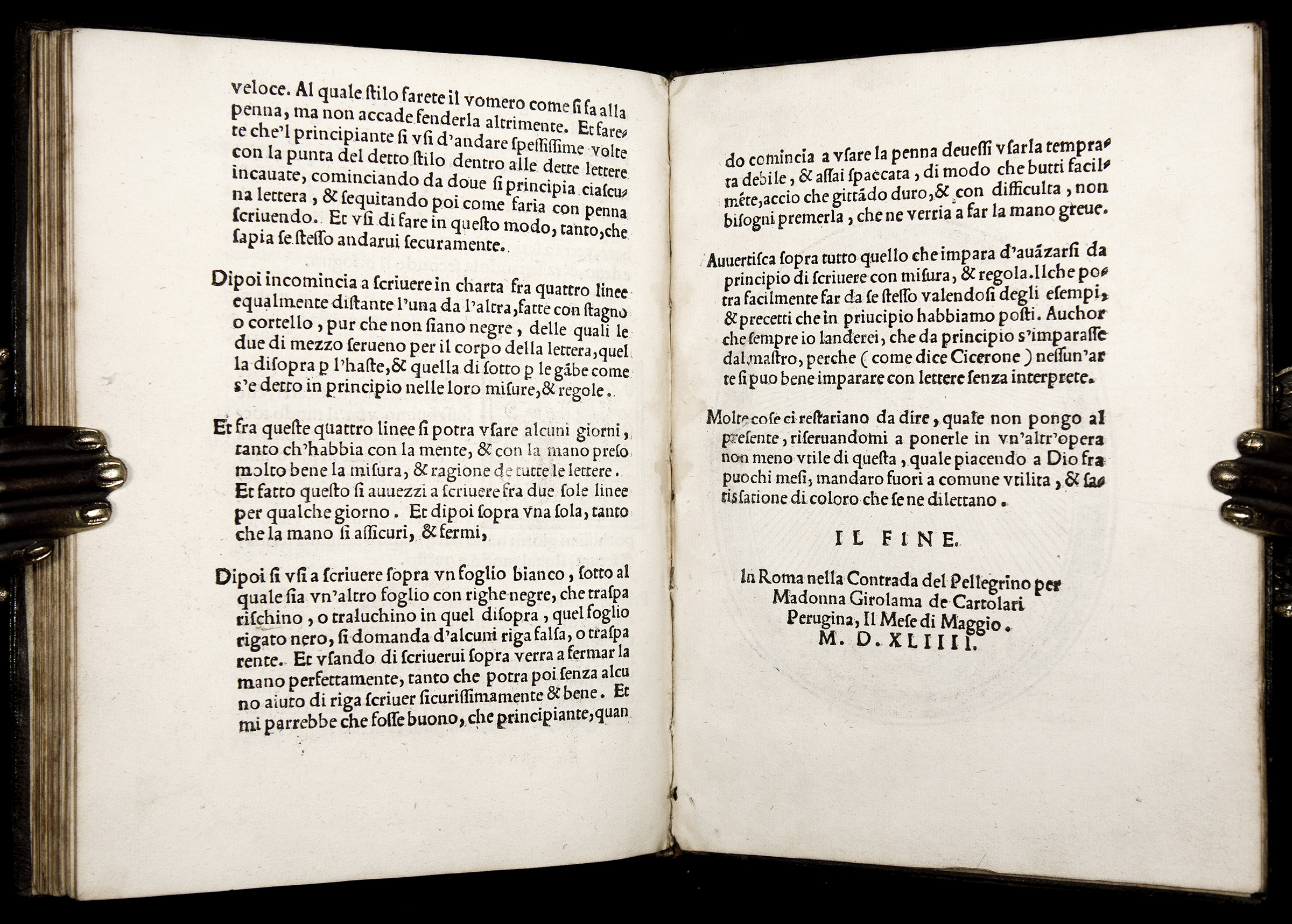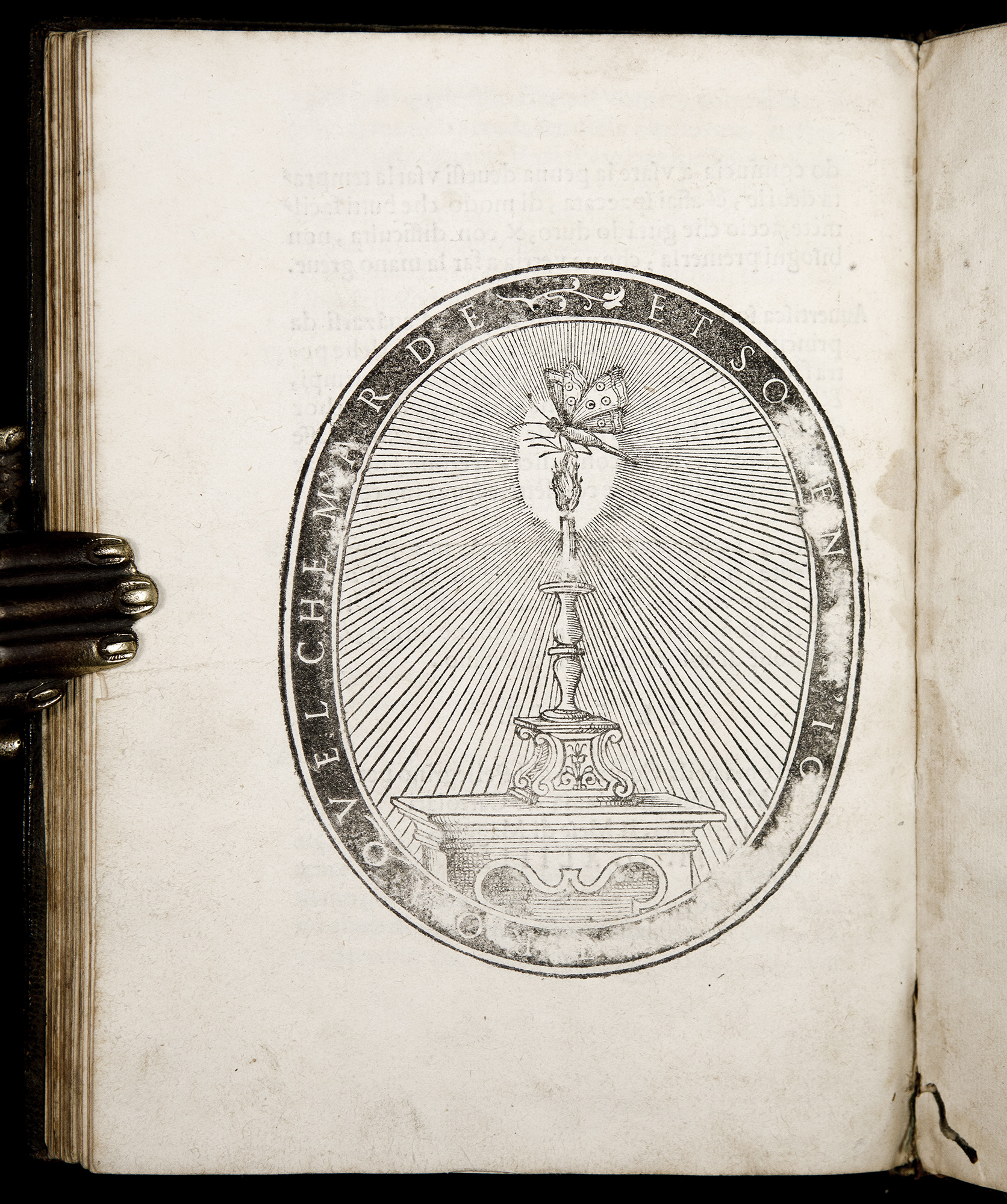
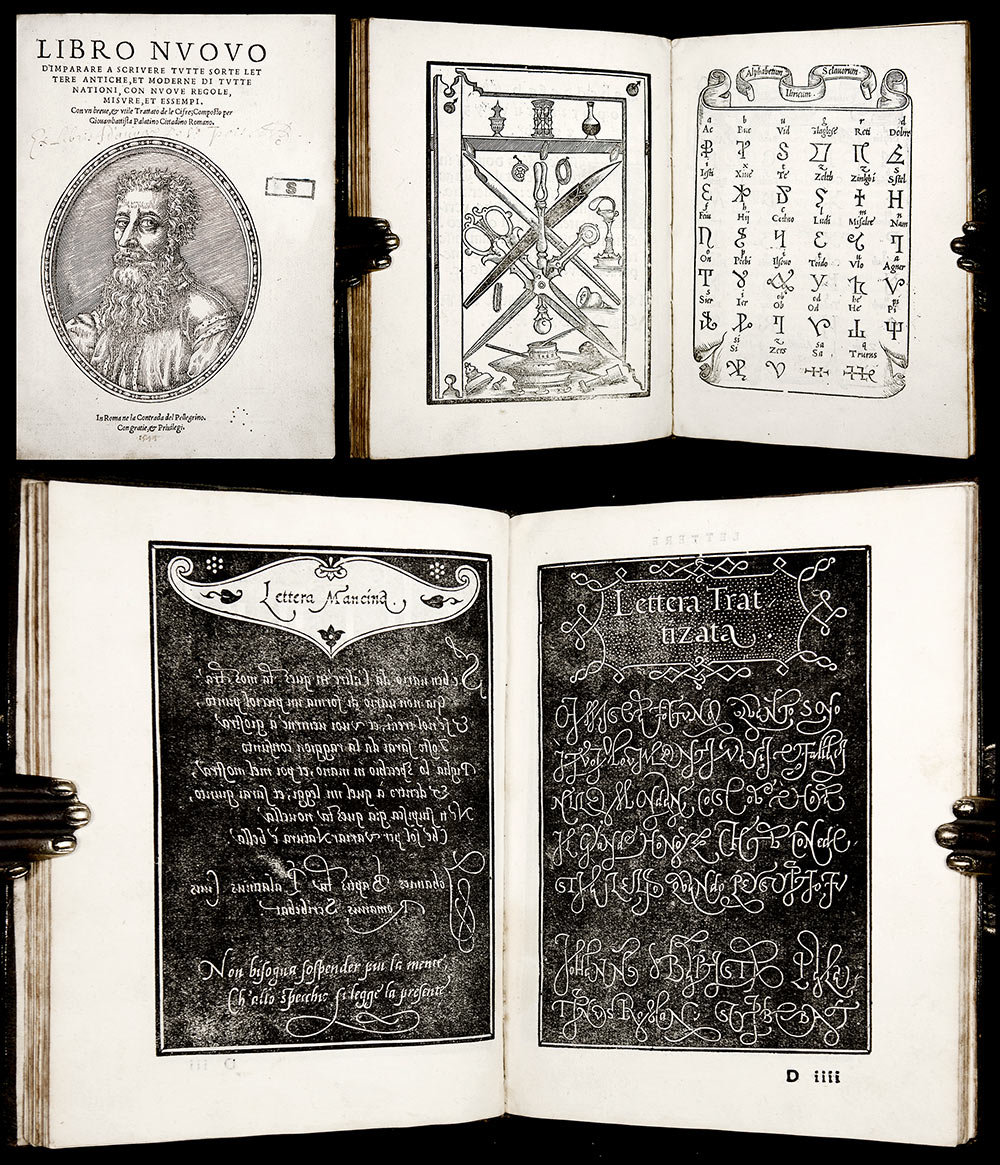
[Calligraphy and Penmanship - Renaissance] [Ciphers and Rebuses] [Early Women Printers]
Giovanni Battista Palatino
Libro nuovo d'imparare a scrivere
tutte sorte lettere antiche, et moderne di tutte nationi,
con nuove regole, misure et essempi.
Con un breve, et utile trattato de le cifre.
Rome: Girolama de Cartolari, May 1544.
$4,700
Text in Italian. Illustrated with numerous full-page woodcuts.
Rare Third Edition (printed by a woman!) of Palatino’s vastly popular illustrated calligraphy manual, noted for its examples of cursive chancery scripts, mercantile hands, and national hands, while also including non-western scripts (such as Hebrew, Chaldean, Arabic, Greek, Egyptian, Syrian, Indian, Cyrillic, etc.), a rebus and cipher alphabets, as well as “Lettera Mancina” (right-to-left handwriting, of the kind practised by Leonardo). The book also includes two additional short texts: Delle Cifre (“On ciphers”), considered “a genuine contribution to cryptography” (Arthur Osley) and De gli instrumenti (“On the [writing] instruments”), dealing with practical aspects of writing, including recipes for inks, advice on pens, and learning to write.
The first edition was printed in 1540 by Baldassare Cartolari for Bernardo Giunta 1540; and the 2nd (1543) and this 3rd Edition (1544) were printed by his widow Girolama Cartolari, one of the earliest Italian women printers, and likely the first female printer in Rome! The two editions (1543 and 1544) produced by Girolama Cartolari are both rather rare!
Giovanni Battista (or Giambattista) Palatino (c. 1515 - c. 1575), was an Italian Renaissance calligrapher and notary ‘by Apostolic authority’. Born in Calabria, Palatino moved to Rome as a young man, and played an active part in the Roman intellectual life of the mid 16th century, serving as secretary of the Accademia degli Sdegnati, an informal association of humanists founded by Girolamo Ruscelli, where he befriended Francesco Molza and Claudio Tolomei (both mentioned here in his dedicatory epistle to Cardinal Robert de Lenoncourt).
“Palatino's book is interesting for what it tells us about the ordinary writing of that time. Most documents in the sixteenth century were still written in varieties of Gothic cursive and Palatino illustrates examples of such hands from Milan, Rome, Venice, Florence, Sienna and Genoa. In fact almost every great commercial centre or large organisation such as the papal writing office had developed its own variety of writing. Writing was not as homogeneous as it is today and there were many different styles in use concurrently.” (Ewan Clayton, ‘A History of Learning to Write’)
“With the publication of Giovanni Battista Palatino's Libro nuovo d'imparare a scrivere (Rome, 1540), the practical function of the writing manual gave way more dramatically than before to both the aesthetic potential of script and the force and personality of the scribe. The focus of Palatino’s book remained chancery cursive, and, as in earlier writing manuals, it included a full complement of practical scripts ranging from chancery alphabets to various mercantile and bastard (localized Gothic cursive) hands. Not content merely to equal the expertise of earlier authors, however, Palatino aimed for encyclopedic mastery of all writing , which he demonstrated by including an unusually large and inventive selection of indigenous and foreign hands, as well as exhibition scripts such as florid Gothic letter types, mirror writing, and decorative alphabets.” (Lee Hendrix, Thea Vignau-Wilberg. The Art of the Pen: Calligraphy from the Court of the Emperor Rudolf II, p.8)
Of considerable interest are the examples of rebuses or pattern poems included in Palatino’s Libro nuovo, such as the sonetto figurato beginning Dove son gli occhi e la serena forma… (leaves E6v-8r of our edition): “the visual sonnet […] cast in the popular form of the rebus, [that] relies on the relationship and the exchange of words and images.” (Davide Del Bello, Forgotten Paths: etymology and the allegorical mindset, p.129)
“Writing books from this period [16th century] are extremely valuable to palaeographers because they provide a portrait of the history of the last creative period in Latin calligraphy to which we owe all the graphic forms of western civilization. Palatino's treatise is among the most important in the genre: his collection of writing models, writes Casamassima, became the best known and most reissued of all time.
“In 1540 Palatino was a young man, about thirty years old. Originally from Calabria, he had become a Roman citizen only two years earlier , and he was extremely proud of his status as civis Romanus. He was a professional calligrapher, and the secretary of the Accademia dello Sdegno [‘Academy of the Disdainful’], to whom he dedicated his Libro nuovo. The interests and humours of Pope Paul III's Rome were well represented in the life of the Academy: the love of letters was joined to a taste for practical jokes and extravagance, and a lively carnival spirit. Protected by the young Cardinal Alessandro Farnese, the Academy could count many illustrious individuals among its members. […]
“From its very title it is clear that Palatino's book associates calligraphy with ciphers. This association had already become a tradition, and it was indicative of the variety of the ideas that were coalescing around the letters of the alphabet. The writing models intended to be used for the different scripts were intertwined with ancient models (or, in some cases, pseudo-antique ones) and with exotic, imaginary alphabets. The expansion of the known world and new antiquarian studies stimulated not only better documentation of the various types of alphabets but also wonderful games of variation and invention. [...] It was only natural, then, for a calligrapher like Palatino to be fascinated by ciphers, and more generally by the metamorphosis of the alphabet. He named Ruscelli, Atanagi, and Trifone Benci (died 1572), all members of the Academy, as his teachers in matters of 'ciphers.' Ciphers were clearly a shared interest, but the concerns of each give us an idea of the different forms that the blend of script and ciphers could take . Ruscelli was especially interested in the technical , experimental aspect of the art of writing. […] He was above all a true master of the 'secrets,' that is, those practices very near to magic which taught how to make things appear and disappear. Palatino writes, in fact, that he has learned from Ruscelli 'some wonderful and useful secrets for invisible writing on glass’. […]
“The sonetto figurato (shaped sonnet) appears in the section of Palatino’s book dedicated to ciphers. It is coupled with cifre quadrate (squared ciphers), in which the letters of an entire word (all capitals) are condensed into one square. Palatino writes that they are made 'only for pleasure and beauty'. Thus, the textual space in which the sonetto figurato appears is devoted to a form of communication that simultaneously reveals and conceals, the product of virtuoso skill and play.” (Lina Bolzoni, The Gallery of Memory: Literary and Iconographic Models in the Age of the Printing Press, p.87-90)
An old-style serif typeface designed by Hermann Zapf in mid 20th century was named ‘Palatino’ after Giovanni Battista Palatino. “Along with many of the best type designers of this century, Zapf returned to the letter forms of the Italian Renaissance in the preparation of Palatino. Although he wished to call the new face Medici, it was the decision of the foundry staff that it be named Palatino, after Giovanbattista Palatino, a sixteenth-century calligrapher and contemporary of the punchcutter Claude Garamond. Palatino's writing manual, Libro Nuovo d'Imparare a Scrivere, was published in Rome in 1540. Although a controversial figure among his fellow scribes, Palatino has been called by the historian of calligraphy James Wardrop a ‘calligrapher’s calligrapher’.” (A. Lawson, Anatomy of a Typeface, p.124)
Physical description:
Quarto; leaves measure 192 mm x 140 mm. Bound in full 16th- (or early 17th-) century full brown calf; spine with raised bands and decorated in blind with small rosette tools in compartments. (Housed in a fine 20th-century custom-made morocco clamshell box, with guilt lettering to spine.)
52 [unnumbered] leaves (forming 104 pages).
Signatures: A-F8 G4.
COMPLETE.
Title-page with a large woodcut portrait of the author in an oval medallion; further illustrated with over sixty full-page woodcuts of calligraphic models, alphabets, ciphers, and writing instruments (some on black background); author's emblematical device (a moth fluttering over a candle flame, accompanied by a verse from Petrarch) on the final leaf verso (G4v).
Several large woodcut initials.
Preliminaries include a statement of printing Privilege from Pope Paul III (leaf A2r), and a dedicatory epistle to Cardinal Robert de Lenoncourt (leaf A3r-4v), both dated 1540.
Colophon on G4r (with a woodcut device on verso).
Condition:
Very Good antiquarian condition. Complete. Binding slightly rubbed, with minor, neat (and almost unnoticeable) repairs to ends of spine; binding very solid with leather supple and lustrous. Internally, with only light occasional marginal soiling. A small old collector’s stamp (with a letter ‘S’) to outer margin of the title page and of leaf F2r; also a (faded) 15th-century ownership inscription to title page. Some abrasions to verso of the final leaf, partially affecting the border of the woodcut device. Rear endpapers with minor worming near gutter, as well as a small calligraphic pen-trial in a gothic script and a small ink drawing of an eye. In all, a very pleasing, clean, genuine, wide-margined example of this fascinating, rare, beautifully produced book.
Bibliographic references:
Censimento Nazionale 23838; Brunet IV, 314; Bonacini 1335. Marzoli, Calligraphy, p.37.

